Better Sailing
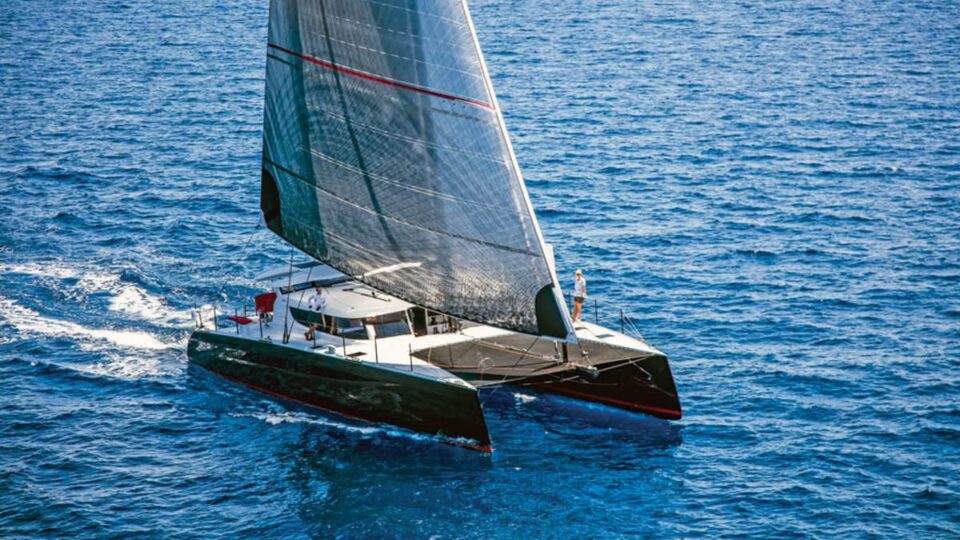

How Fast Do Catamarans Sail? Average Sailing Speed of a Catamaran
In most aspects, sailing a catamaran is very similar to sailing a monohull. If you learn to sail on a monohull then most of the skills are transferable. But, there are a couple of subtle differences that we will analyze further in this article. A catamaran is generally more balanced on the water and can be faster than a multi-hull vessel. And, cruising on a sailboat with a cat hull will be much faster than cruising on a sailboat with a monohull. Therefore, a catamaran hull is able to achieve the speeds of a racing monohull and is also more comfortable to sail on.
A tri-hull is even much better as they’re designed towards the performance end of the spectrum. And that is why they double the speed of a racing monohull. So, let’s analyze this subject further in this article and see what’s the average sailing speed of a cat. Follow me!
Catamaran Vs Monohull Speed: Are Cats Faster than Monohulls?
Not all cruising cats are always faster than an equivalent length monohull. But, many well-designed and balanced multihulls can easily surpass the speed of their monohull cousins. And, it’s not fair to mass all cats into one example, but performance cruising catamarans like the Nautitech or Neel trimarans distinguish from others. Their narrow waterline beams, hull chines, deep and fine keels, and rudders as well as efficient sail plans will typically be faster than the average cruising monohull.
“The fun of sailing is proportional to the speed of sailing”, as an American designer, L. Francis Herreshoff, said. And, it’s basically true because when we sail and see another boat heeling in the breeze, we also feel we want to do the same. This is because for many sailors speed means much more than just fun. You should, however, consider keeping your cat as light as possible if you want to maximize speed. I know that keeping your sailboat light is difficult but it’s of importance if speed is your main goal.
Keep in mind that a boat’s speed has won wars and has also been a contributor to safety. In the past, a fast warship was able to outmaneuver its adversary or escape from a boat with more firepower. And just as proven in history, the speed of a sailboat is important and provides a faster boat with more options.
Monohull VS Catamarans Differences
- When tacking, you must work hard to keep your speed consistent in the tack and always ease the mainsheet to avoid “windvaning.” When the larger mainsail on a catamaran attempts to turn the boat back towards the wind, this is known as windvaning.
- On a monohull, you must be extremely cautious about an unintended gybe. Meaning that you must gybe much more slowly. On a catamaran, you can take advantage of the increased speed and sustain it while gybing to help depower the main.
- On a monohull, and when winds increase, the boat starts heeling. This automatically informs you that you have too much sail up and it’s time to reef. And, as catamarans don’t heel, you have to be very careful when to reef the massive main. Most of the time, you will throw in the first reef at 18-20 knots of wind speed. The second reef will be put as the wind gets closer to 23-25 knots. The above-mentioned always depend on the size and type of your vessel.
Wind as a Main Factor for Speed
Thanks to tech evolutions in radar, satellite, and computer technology, a five-day forecast is as accurate as a two-day forecast was back in 1980. A multihull’s higher speed also contributes to easier and safer planning of ocean passages around weather windows since exposure time will be less. Moreover, meteorological prediction for shorter periods is far more accurate. Keep in mind that when sailing faster you also introduce the concept of apparent wind to the strategy of efficient sailing.
Multihull speed upwind? Sailing upwind, the catamaran usually experiences more apparent wind across the deck since it’s sailing faster. Therefore, the sails will feel more pressure, which will make the boat perform even better. And, of course, the concept of apparent wind contributes to the joy of sailing, as it adds another dimension to it. When sailing towards a downwind destination, fast multihulls are able to sail at smaller wind angles. Subsequently, this brings the apparent wind forward of the beam, hence optimizing the angle of attack on the sails.
While cats will fly gennakers, code-zeros, or asymmetric spinnakers, monohulls mostly set symmetric spinnakers to the poles. And most importantly, their boat speed will often cancel out the true wind and will reduce the apparent wind and performance. The faster the multihull is the more it is able to take advantage of the apparent wind and tack downwind towards its destination. Although it might be sailing twice the distance, it will arrive at the downwind mark quicker because its Velocity Made Good (VMG) will be faster.
>>Also Read: How Fast is a Laser Sailboat? Laser Sailboat Top Speed
Performance Characteristics
Bear in mind that cats require four times the power to double their speed. But, a mono-hull vessel requires eight times the power to double the speed. This is due to the fact that a cat has less resistance in the water. However, this is great in terms of conserving and using less energy. Catamarans are also more stable in the water. This stability is effective at resisting heeling or capsizing. In other words, a multi-hull vessel requires four times the force to capsize as a similar-sized mono-hull vessel.
Most of the time, sailing in a catamaran is smoother and facilitates activities that are not always possible on a mono-hull sailboat. In addition, as catamarans have less water resistance, they are generally faster than mono-hull vessels. As their hulls are smaller, this means that they have a smaller bow wave to fight. The bow wave is a wave created by the displacement of water by the bow of a ship. After a certain speed, the boat has to start hauling itself over its own bow wave. Meaning that the larger hull a boat has, the larger its bow wave will be and the more power will be required in order to fight it.
Since catamarans have two small and narrow hulls, they don’t have much of a bow wave. This is one of the reasons they are normally quicker than a monohull vessel of comparable size. Catamarans can travel at speeds of up to 30% faster than monohull boats. Catamarans have the disadvantage of taking longer to transform than monohulls.
Lastly, the thing that makes monohulls harder to sail is heeling and smaller spaces. In stronger winds, monohulls tend to heel. This results in making most tasks a bit more difficult to perform. Whether you’re heading forward to reef, trying to winch in a sail, or move about the boat, sailing on a heeling boat is always more difficult. However, cats have extra stability and room, and this allows for much easier movement around the boat as they do not heel. And, for this reason, catamarans are often considered easier to sail.
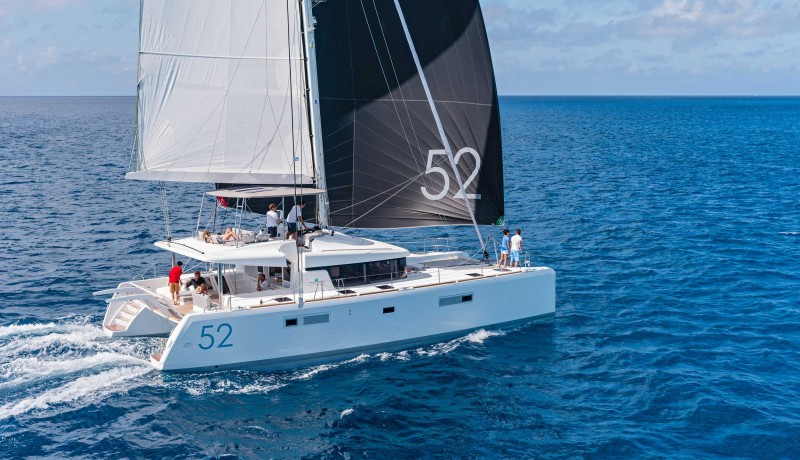
How Fast Are Catamarans Compared To Other Boat Types?
There are two main factors that determine the speed of ships. The first one is the hull type. There are hulls that stay beneath the water more or less than others. But, keep in mind that the less the hull is underwater, the faster it can go. This is due to the fact that the less of the hull underwater, the less the drag created when sailing. The other factor is the length of the boat. And, reasonably, the longer the boat, the faster it can go. Every boat has a maximum hull speed that can’t be exceeded. This can only happen in case the boat can plane on the water’s surface or be lifted on hydrofoils. For most boats, the longer the boat, the higher the maximum hull speed is.
Sailing catamarans typically average about 10 knots while pontoon boats average about 16 knots. As for powerboats, they can average anywhere between 30 and 50 mph. Most average sailboats are designed with monohulls and they average from 6 to 9 knots depending on wind conditions. Generally, sailboats average between 8 and 12 mph, again depending on weather conditions. This includes mono-hull between 6 to 8 mph and cats or trimarans between 9 and 10mph.
Speed and Comfort Considerations For Cats
You have a lot of choices if you choose to buy a catamaran. You have the option of prioritizing speed or comfort. After you’ve decided to buy a catamaran, the type of catamaran you can consider is determined by where you’ll be using it and what you’ll be doing with it. In addition, make sure that you look at what type of water you will be traveling in, your crew members, and what type of speed you want to achieve.
Storage is an important consideration to make before purchasing a catamaran. Due to the beam, or width, of a catamaran versus a regular mono-hull vessel, you are often charged for two slips if you wish to store your boat in a marina. Moreover, catamarans are a great option for those who get seasick because they have a more stable ride and more open air space. You have more windows and visibility since the living quarters are not within the hull and below the water’s surface.
Sailing and power catamarans are both great choices. In addition, for low winds or conditions such as docking in a marina, sailing catamarans may be equipped with backup power engines. Twin-engine catamarans can have more power and precision than mono-hull vessels.
>>Also Read: How Fast Can Sailboats Go?
Main Advantages of Catamarans
- Space! If you want to opt for more interior and exterior space then the two separate hulls of a catamaran can often double the amount of social space than a monohull of the same length.
- Catamarans are far more stable than monohulls. For this reason, they don’t heel when sailing, and are less prone to rocking when at anchor. This factor also contributes to comfortable sailing.
- Catamarans have a shallow draft which allows them to enter shallower areas. Keep in mind that in the South Pacific, most lagoons are 6 to 8 ft in depth. This depth doesn’t allow for monohulls to enter, but a catamaran can easily enter these areas.
- Stability is another big plus of cats. A cat isn’t that susceptible to the effects of wave action and it also doesn’t heal the way a monohull does. Therefore, it’s much easier to walk around on deck and within the interior of the cat while underway.
- In terms of speed, and mostly for downwind sailing , cats are faster than monohulls. This particularly applies to downwind runs, reaches, and broad reaches.
- More light, customizable, and airy living area. On a catamaran, the living space is usually situated in the middle of the boat and built on the bridge deck. But, in a monohull you go down into the hull where it is darker and less airy.
- More storage space and room for extra systems, provisions, and general sailing equipment. These may include air conditioning, heaters, oven, watermakers, generators, larger fridges, and freezers, etc. And, if you’re a liveaboard, then living on a cat is far more comfortable than living in a sailboat. You have more interior, exterior, and storage space as well as stability and speed in terms of sailing performance.
- Many modern cats have flybridge helms. And of course, no monohull achieves this visibility from the helm provided on most modern catamarans.
- The galley, main salon, and cockpit are all located on one level , above the waterline.
- Because the majority of living space is above the waterline , there’s a better flow of ventilation on a cat making the need for air conditioning somewhat less important during the daylight hours.
- When you plan to set sail, you almost never have to rush around stowing stuff or using bungee cords to hold things in place. Except in relatively rough waters, most things stay put.
- Since catamarans lack a large, heavy keel filled with lead, they can float even if they’re holed. Production cats are constructed with so much buoyancy that sinking them is nearly impossible.
- Catamarans are usually easy to dock because you have two motors and two rudders. Additionally, there’s also no need for a bow thruster.
- Most catamarans are able to turn 360 degrees within their own length.
Average Sailing Speed of Catamarans
How fast do catamarans sail – the bottom line.
Bear in mind that not all catamarans are created equal. In other words, catamaran speed is relative. The most important benefit of the speed of a multihull is the ability to outrun bad weather. Meaning that you’re able to average 9-10 knots on a catamaran rather than 6-7 knots on a monohull. Subsequently, this will give you more options in your strategy to avoid bad weather. In general, sailing catamarans typically average about 10 knots. Higher maximum and average speeds are what makes cats distinguish as well as their stability. These are the most important characteristics which makes many sailors prefer cats rather than monohull boats.
Peter is the editor of Better Sailing. He has sailed for countless hours and has maintained his own boats and sailboats for years. After years of trial and error, he decided to start this website to share the knowledge.
Related Posts

Atlantic vs Pacific: Which is More Dangerous for Sailing?

Lagoon Catamaran Review: Are Lagoon Catamarans Good?

Best Inboard Boat Engine Brands

Are O’Day Sailboats Good? A Closer Look at a Classic Brand
- Buyer's Guide
- Destinations
- Maintenance
- Sailing Info
Hit enter to search or ESC to close.
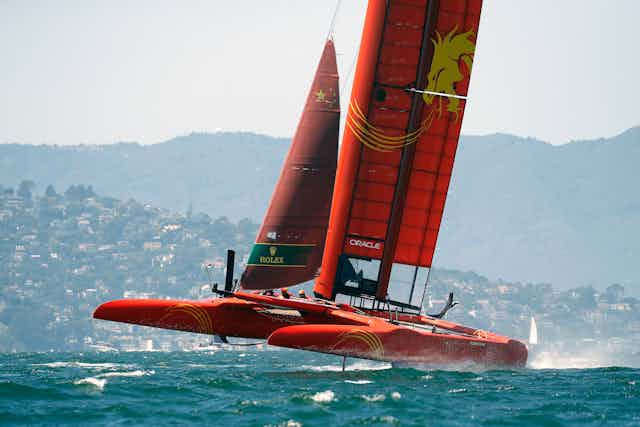
Sail GP: how do supercharged racing yachts go so fast? An engineer explains
Head of Engineering, Warsash School of Maritime Science and Engineering, Solent University
Disclosure statement
Jonathan Ridley does not work for, consult, own shares in or receive funding from any company or organisation that would benefit from this article, and has disclosed no relevant affiliations beyond their academic appointment.
View all partners
Sailing used to be considered as a rather sedate pastime. But in the past few years, the world of yacht racing has been revolutionised by the arrival of hydrofoil-supported catamarans, known as “foilers”. These vessels, more akin to high-performance aircraft than yachts, combine the laws of aerodynamics and hydrodynamics to create vessels capable of speeds of up to 50 knots, which is far faster than the wind propelling them.
An F50 catamaran preparing for the Sail GP series recently even broke this barrier, reaching an incredible speed of 50.22 knots (57.8mph) purely powered by the wind. This was achieved in a wind of just 19.3 knots (22.2mph). F50s are 15-metre-long, 8.8-metre-wide hydrofoil catamarans propelled by rigid sails and capable of such astounding speeds that Sail GP has been called the “ Formula One of sailing ”. How are these yachts able to go so fast? The answer lies in some simple fluid dynamics.
As a vessel’s hull moves through the water, there are two primary physical mechanisms that create drag and slow the vessel down. To build a faster boat you have to find ways to overcome the drag force.
The first mechanism is friction. As the water flows past the hull, a microscopic layer of water is effectively attached to the hull and is pulled along with the yacht. A second layer of water then attaches to the first layer, and the sliding or shearing between them creates friction.
On the outside of this is a third layer, which slides over the inner layers creating more friction, and so on. Together, these layers are known as the boundary layer – and it’s the shearing of the boundary layer’s molecules against each other that creates frictional drag.
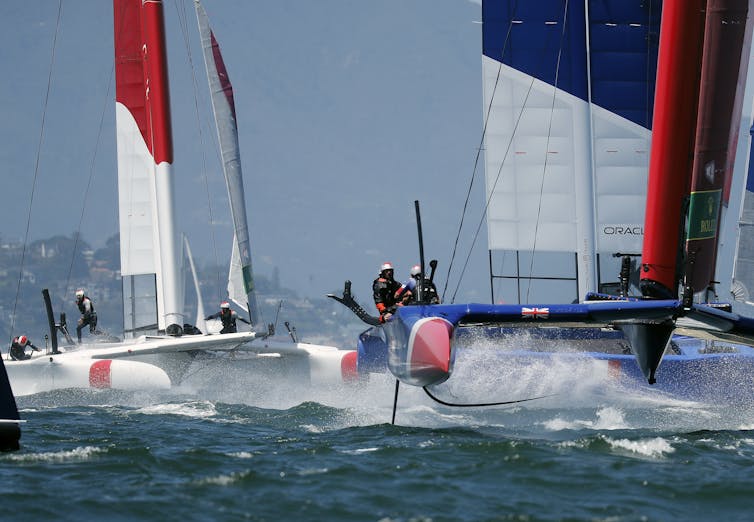
A yacht also makes waves as it pushes the water around and under the hull from the bow (front) to the stern (back) of the boat. The waves form two distinctive patterns around the yacht (one at each end), known as Kelvin Wave patterns.
These waves, which move at the same speed as the yacht, are very energetic. This creates drag on the boat known as the wave-making drag, which is responsible for around 90% of the total drag. As the yacht accelerates to faster speeds (close to the “hull speed”, explained later), these waves get higher and longer.
These two effects combine to produce a phenomenon known as “ hull speed ”, which is the fastest the boat can travel – and in conventional single-hull yachts it is very slow. A single-hull yacht of the same size as the F50 has a hull speed of around 12 mph.
However, it’s possible to reduce both the frictional and wave-making drag and overcome this hull-speed limit by building a yacht with hydrofoils . Hydrofoils are small, underwater wings. These act in the same way as an aircraft wing, creating a lift force which acts against gravity, lifting our yacht upwards so that the hull is clear of the water.

While an aircraft’s wings are very large, the high density of water compared to air means that we only need very small hydrofoils to produce a lot of the important lift force. A hydrofoil just the size of three A3 sheets of paper, when moving at just 10 mph, can produce enough lift to pick up a large person.
This significantly reduces the surface area and the volume of the boat that is underwater, which cuts the frictional drag and the wave-making drag, respectively. The combined effect is a reduction in the overall drag to a fraction of its original amount, so that the yacht is capable of sailing much faster than it could without hydrofoils.
The other innovation that helps boost the speed of racing yachts is the use of rigid sails . The power available from traditional sails to drive the boat forward is relatively small, limited by the fact that the sail’s forces have to act in equilibrium with a range of other forces, and that fabric sails do not make an ideal shape for creating power. Rigid sails, which are very similar in design to an aircraft wing, form a much more efficient shape than traditional sails, effectively giving the yacht a larger engine and more power.
As the yacht accelerates from the driving force of these sails, it experiences what is known as “ apparent wind ”. Imagine a completely calm day, with no wind. As you walk, you experience a breeze in your face at the same speed that you are walking. If there was a wind blowing too, you would feel a mixture of the real (or “true” wind) and the breeze you have generated.
The two together form the apparent wind, which can be faster than the true wind. If there is enough true wind combined with this apparent wind, then significant force and power can be generated from the sail to propel the yacht, so it can easily sail faster than the wind speed itself.
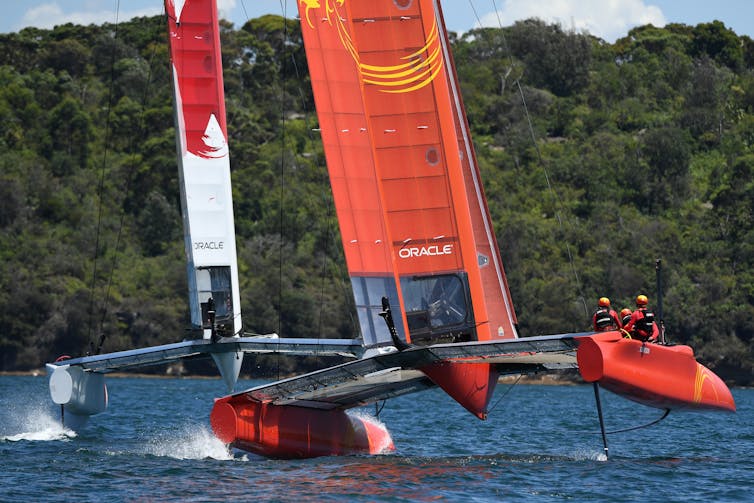
The combined effect of reducing the drag and increasing the driving power results in a yacht that is far faster than those of even a few years ago. But all of this would not be possible without one further advance: materials. In order to be able to “fly”, the yacht must have a low mass, and the hydrofoil itself must be very strong. To achieve the required mass, strength and rigidity using traditional boat-building materials such as wood or aluminium would be very difficult.
This is where modern advanced composite materials such as carbon fibre come in. Production techniques optimising weight, rigidity and strength allow the production of structures that are strong and light enough to produce incredible yachts like the F50.
The engineers who design these high-performance boats (known as naval architects ) are always looking to use new materials and science to get an optimum design. In theory, the F50 should be able to go even faster.
- Engineering
- Aerodynamics

Data Manager

Research Support Officer

Director, Social Policy

Head, School of Psychology

Senior Research Fellow - Women's Health Services
How is Catamaran Sailing Different from Monohull Sailing?
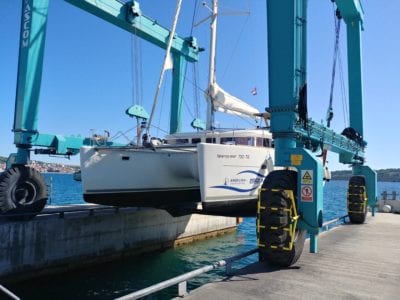
Sailing a catamaran is very similar to sailing a monohull in most aspects. If you learn to sail on a monohull, most of the skills are easily transferable. However, there are a couple of subtle differences that one has to be aware of:
- When tacking, you must work hard to maintain your speed throughout the tack and often need to ease your mainsheet to prevent “windvaning”. Windvaning is when the larger mainsail on a catamaran tries to turn the boat back into the wind.
- When gybing on a monohull, you must be very careful of an accidental gybe, and so you gybe much more slowly. On a catamaran, you can use the increased speed to your advantage and maintain speed while gybing to help depower the main.
- On a monohull, as winds increase, the boat starts heeling which lets you know that you have too much sail up and it’s time to reef. On a catamaran, because they do not heel, you have to be very careful in terms of when to reef the massive main. Typically, you will throw in the first reef at 18-20 knots of wind speed (depending on the size of your vessel) and put in a second reef as the wind gets closer to 23-25 kts)
Most aspects of sailing a catamaran are very similar to a monohull, so making the transition to a sailing catamaran is usually not that challenging of a process!
Why are Catamarans Popular?
Catamarans have exploded in popularity in the last 5 years! There are many advantages to catamarans over monohulls.
- Much more space on a catamaran!
- Catamarans are far more stable than monohulls so they do not heel when sailing, and are less prone to rocking when at anchor. Making for a much more comfortable boat!
- Catamarans have a shallow draft which allows them to enter shallower areas. In the South Pacific, most lagoons are 6-8 feet deep. This is too shallow for monohulls to enter, but a catamaran can easily enter these lagoons.
- Speed: Often, especially downwind, catamarans are faster than monohulls
- More light and airy living area. On a catamaran, the living space is usually up in the middle of the boat, built on the bridge deck whereas in a monohull you go down into the hull where it is darker and feels less open.
- More storage space and room for extra systems like air conditioning, water makers, generators, larger fridges and freezers, etc… Again, having room for all these amenities makes for more comfortable living.
What is a Catamaran?
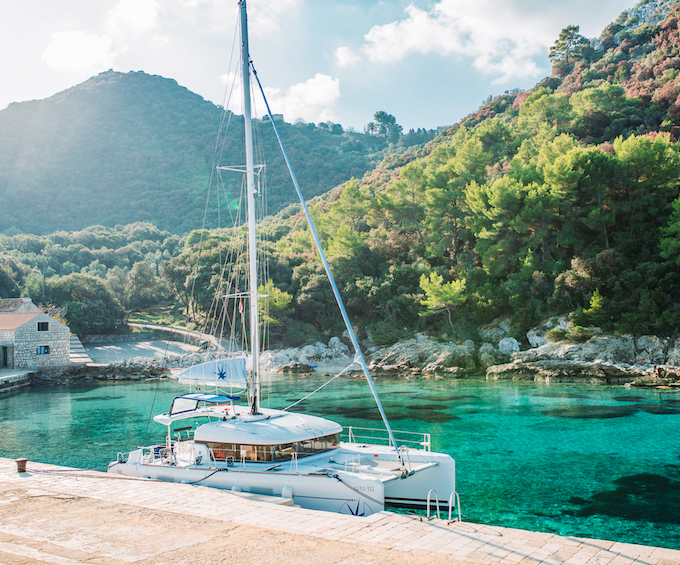
A catamaran is a sailboat with two hulls. These two hulls are connected by a bridge deck. Many people will be familiar with Hobie cats, small catamarans that are popular for sailing on lakes and in calmer waters. Cruising catamarans are based on this same principle but have large hulls that can fit many cabins inside, and house large structures on the bridge deck (like a galley, salon and living area).
Are catamarans safer than monohull sailboats?
Great question! Catamarans are much more stable than monohulls, and so people are less likely to fall overboard, which does make them safer in this aspect. They are larger, more stable boats, and so in most situations, this will make them a “safer” sailboat than a comparably sized monohull.
Catamarans also have the advantage of having 2 engines, which makes them “safer” when it comes to engine problems. On a monohull sailboat , if you have major engine problems you only have the option of sailing. On a catamaran, you always have a second motor ready to help out in an emergency!
Are catamarans easier to sail?
What makes monohulls harder to sail is heeling and more confined spaces. In stronger winds monohulls heel, making most tasks a little more difficult to manage. Whether you are going forward to reef, trying to winch in a sail or moving about the boat, sailing on a heeling boat is more challenging. Catamarans, however, because of their extra stability and room, allow for much easier movement around the boat as they do not heel. For this reason, catamarans are often considered “easier” to sail.
Can a catamaran cross the Atlantic?
Definitely! Early on many catamarans and trimarans were home-built from kits, and many of these boats gave catamarans a bad rap for offshore sailing. For decades now the major catamaran manufacturers have been improving these amazing vessels, and now catamarans are safe, stable and fast on offshore passages. In 2020 we completed an Atlantic crossing in our very own Never Say Never Lagoon 400S2 catamaran.
How fast does a catamaran sail?
Not all catamarans are created equal. Many of the production catamarans like Lagoon, Fountaine Pajot and Leopard are designed for cruising. This means that they are willing to sacrifice some performance in the interest of comfort for their owners and crew. These boats still are often faster than a monohull of comparable size when on a beam reach or downwind point of sail, often seeing speeds in the double digits. Upwind, catamarans do not usually have the same ability to point into the wind (as they have shorter, stubbier keels) and do not travel as quickly.
Some high-performance catamarans from manufacturers like Outremer, Gunboat and HH, make incredibly fast catamarans that can achieve speeds in the high teens and low 20s under ideal conditions.
Want to learn more?
Learning to sail a catamaran has it’s differences from monohulls. If you are planning on sailing catamarans, then it’s best to spend a week onboard one learning how to sail and operate these vessels. We offer catamaran sailing courses in the Grenadines (Caribbean), Sea of Cortez (Mexico), Mallorca (Spain) and Tahiti (South Pacific).
Our week-long live aboard courses truly are an incredible experience! You will spend the week learning over 100 different skills and learn to comfortably sail and operate the vessel. Upon successful completion of the course, you will earn ASA certification 101, 103, 104 and 114 (up to Cruising Catamaran certification) which allows you to charter catamarans internationally.
This intensive course will give you the knowledge, skills and experience to charter catamarans, or help you set sail on your vessel! All while having a blast, snorkelling, hiking and exploring exclusive bays.
- Next Post →
HOW IT WORKS
Connect With Us
Plan Your Trip
START YOUR SAILING JOURNEY NOW
As featured in.

EXCLUSIVE EVENTS
The only way to join our tribe is to learn to sail with Nautilus.
We’re really careful to make sure that we know and trust anyone coming on one of our special trips.
Join us on flotillas, offshore deliveries, free webinars and unforgettable sailing adventures around the world. Join the Tribe.
- TERMS OF USE
- Privacy Policy
- Share full article
Advertisement
Supported by
The Blistering Speed of SailGP
The catamarans use wings, not sails, and hydrofoils help the boat fly over the water. It’s like a fast video game, with consequences.

By Kimball Livingston
A generation ago, sailing would not, could not have made the short list of team sports played at highway speeds. The boats that most people race are considered fast at nine knots; screaming at 15. That’s about 10 to 17 m.p.h.
Then came the F50 catamaran in 2019, with wings instead of sails and hydrofoils that lift the boats above the friction of the water, reaching speeds beyond 60 m.p.h., as they seemingly fly above the ocean. Indeed, the crew member helping make that happen is called the flight controller, who manipulates the elevations and angles of the left and right hydrofoils centered between bow and stern.
In SailGP lingo, the controller can fly the boat higher or lower. Higher is faster, but riskier because it also gets the boat closer to a nosedive.
The boats also require a new breed of helmsmen — they call themselves drivers — who direct the rapid-fire team choreography in which decisions must be made in fractions of a second.
The wing trimmer, a term from sail trimming days, shapes the wing — an airfoil — for speed and stability. Compared with fabric sails, a wing can provide more stability even while producing more speed. SailGP wings are built from carbon fiber with titanium fittings under a light plastic wrap. The old days of eyeballing sail shape are gone from these boats.
Data from racing and practicing is accumulated and analyzed to determine optimum wing shape for speed in different conditions, and the trimmer uses hydraulic controls to achieve the target settings.
With more moving parts than an airplane wing, an F50 wing has a larger menu of shape settings.
Given more wind, a sailboat tips over farther and farther until it spills wind out of the sails or loses control. Up to a point, SailGP catamarans just keep going faster. The British team hit a record 53.05 knots. or 61.05 m.p.h., during practice last summer.
“Compared to traditional boats, what is striking in SailGP is the complexity of the control systems,” said Nathan Outteridge , a two-time Olympic medalist who drives for the Japanese team. “I should say that driving is pretty easy, until things go wrong.”
Jason Waterhouse , an Olympic medalist who is flight controller for the Australian team, manages the hydrofoils that go up and down at precise angles with precise timing. Get it wrong, and the boat can nosedive.
“I have to have muscle memory,” Waterhouse said about operating the buttons and dials. It’s like a fast video game, with consequences.
Waterhouse also controls the rake, or angle, on the horizontal flaps on the two rudders the driver uses to steer. The flight controller contributes to level flight by dialing in as much as seven degrees of differential rake between the rudder flaps. The flap on the side being pushed down by the wind is angled to push up, and the flap on the opposite side is angled to push down.
“It adds an extra 300-400 kilos [650 to 900 pounds] of righting moment,” Waterhouse said, referring to the forces working to keep the boat from tipping over.
Paul Campbell-James, the wing trimmer for the U.S. team, said that because much of the boat’s hydraulic power was generated by a battery instead of by a crew member turning a grinding pedestal, his team had given that grinder a second job.
“We set up our forward-facing grinder to also be a tactician,” Campbell-James said. The grinder spins the pedestal’s handles to generate power for the hydraulics but also looks for wind shifts.
Wing shape on these boats has taken over most of the trim-in, trim-out of normal sail control, while contributing to level flight. The key is negative camber, shaping the upper wing to pull opposite to the lower wing, countering the forces trying to tip the boat over. Negative camber adds to the effect of the rudder flaps to make for level sailing. Old school it is not.
In turning maneuvers, the crew switches sides and Campbell-James crosses the boat first to take over driving duties before others follow him across. As they come, if he wobbles the helm, the motion could flick his teammates off the deck.
At the same time, he has to keep the boat level in a dynamic turn, press a foot button to raise a hydrofoil, respond as the wing loads up on the new side and hang on against “G-forces that are unbelievable because, remember, you might be going 50 knots. That’s a lot going on.”
Your source for the latest news on yachts, boats and more. Read through our articles to find out how to compare boats and find the right fit for you!
How fast are catamarans
Oct 26, 2020
less than a min
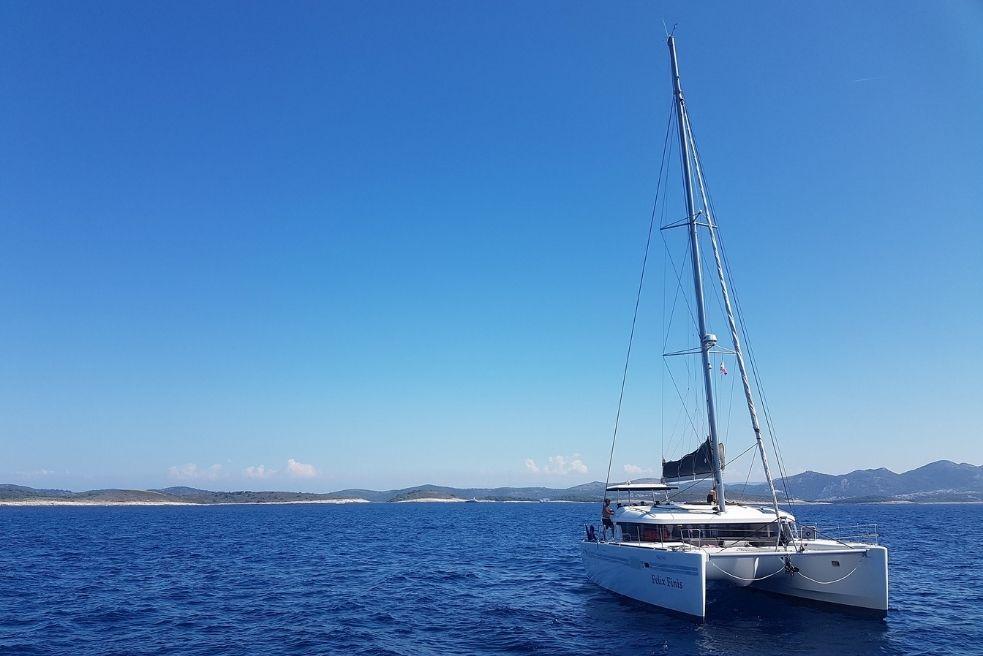
Catamarans are multi-hull vessels composed of two hulls. This geometry allows them to be balanced on water and in turn gain a great deal of speed. Compared to single-hull boats, catamarans are regarded as much faster. But how fast are catamarans actually ?
Catamarans come in various types and sizes. They start from 14 feet up to 100 feet. Each one can reach a different speed limit. Typically, a cruising catamaran sails at 15 knots . A sport cruising catamaran can reach 30 knots . A racing catamaran is somewhat faster and can sail at 45 knots . The power cruising catamaran is probably the fastest vessel and can travel at 70 knots .
One of the main features that make catamarans so fast is the integration of assisting foils that lift the boat off the water. In addition, catamarans are equipped with stability advancements that allow them to gain speed in the ocean.
To better understand how fast catamarans are , they are divided into three groups:
- The sport boats
- The racing ones
- The cruising catamarans
The sport catamarans are recreational vessels designed for a small crew. Their interior is limited as well. Most of them have no living quarters as they are only used for short trips. Some sport catamarans are also used for racing, however, the maximum speed they reach in ideal conditions is 40 knots .
Racing catamarans are used in ocean races and rallies. They are large yachts that can go up to 100 feet and sail at a maximum of 45 knots .
Cruising catamarans on the other hand are more comfortable vessels used for ocean crossing as well. They are equipped with luxurious living quarters. Because of their size, load and volume, these catamarans usually sail at 10 knots , with a maximum speed of 15 knots in ideal conditions.
Some catamarans on the other hand are fitted with powerful motors that favor speed over space. The most common catamaran of this category is the power cruising catamarans . These boats have living quarters and offer the same stability as sailing catamarans. However, the integration of a powerful motor allows these vessels to reach about 70 miles per hour . These catamarans are typically used for passenger travels to shorten the trip between two relatively close destinations such as the mainland and a not-so-remote island.
Power catamarans are also used by the military to transport items. They are particularly on-demand as they can sail in shallow waters as well.
In terms of their performance, catamarans have less resistance to water. Their hulls are smaller so they also have a smaller bow wave created by water displacement to fight. In addition, catamarans only need 4 times the power to double their speed, which is much less power than a monohull would require. Apart from using less energy, catamarans are also good at conserving energy.
Moreover, they are stable and can resist capsizing more than other vessels. They have twin engines that provide more control over speed and stability. Last but not least, catamarans offer smoother voyages and are great for entertainment.
All in all, catamarans can achieve a 30% faster speed than monohulls. Learn more interesting facts about catamarans with TheBoatAPP . Compare these vessels at TheBoatDB . Follow our blog for more interesting facts!
You might like these too

Electric and Hybrid Boats – The Future of Sailing lg ...
Aug 23, 2022
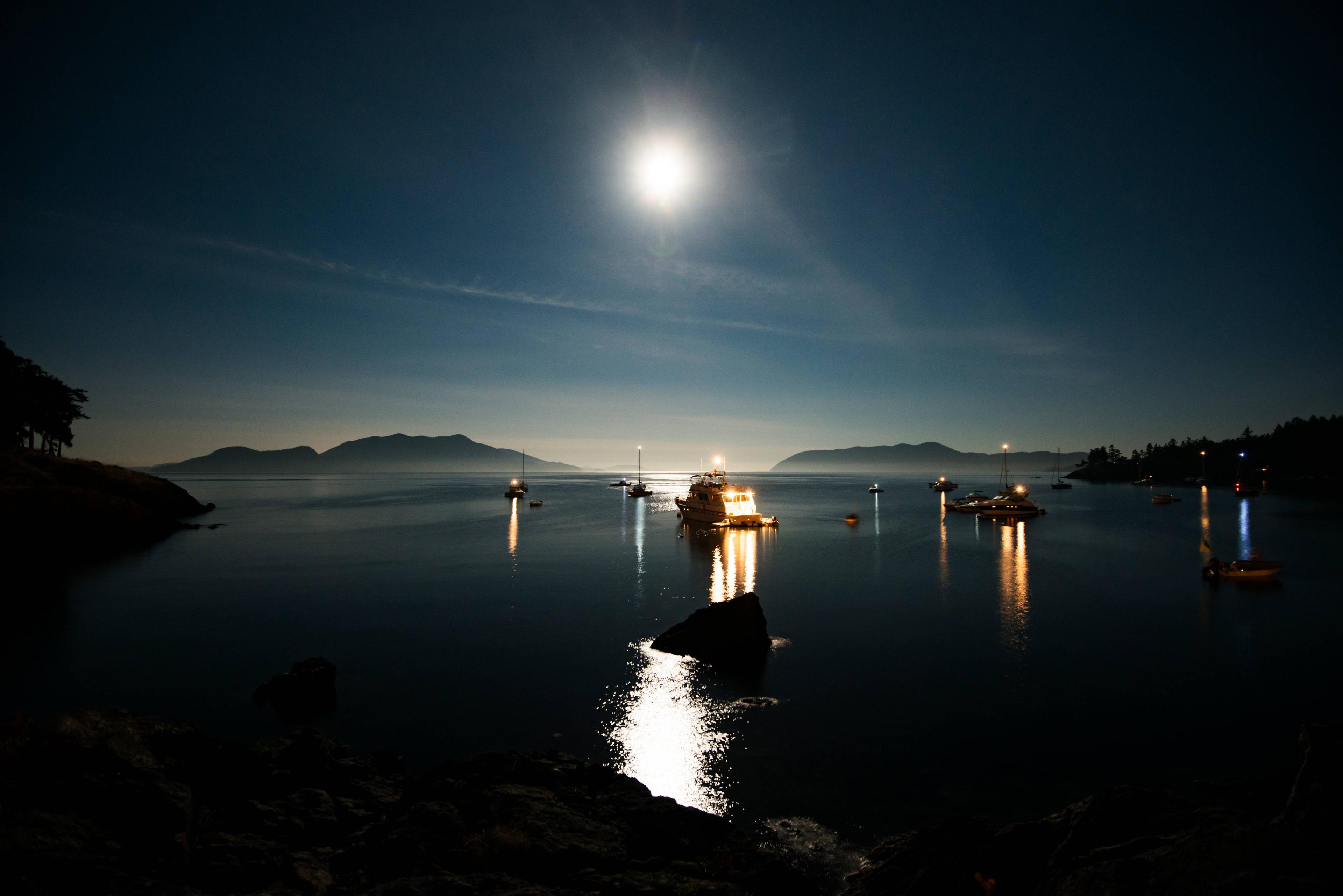
Boat navigation light types and functions lg ...

How Long does it Take to Sail Around the World lg ...
Oct 04, 2021
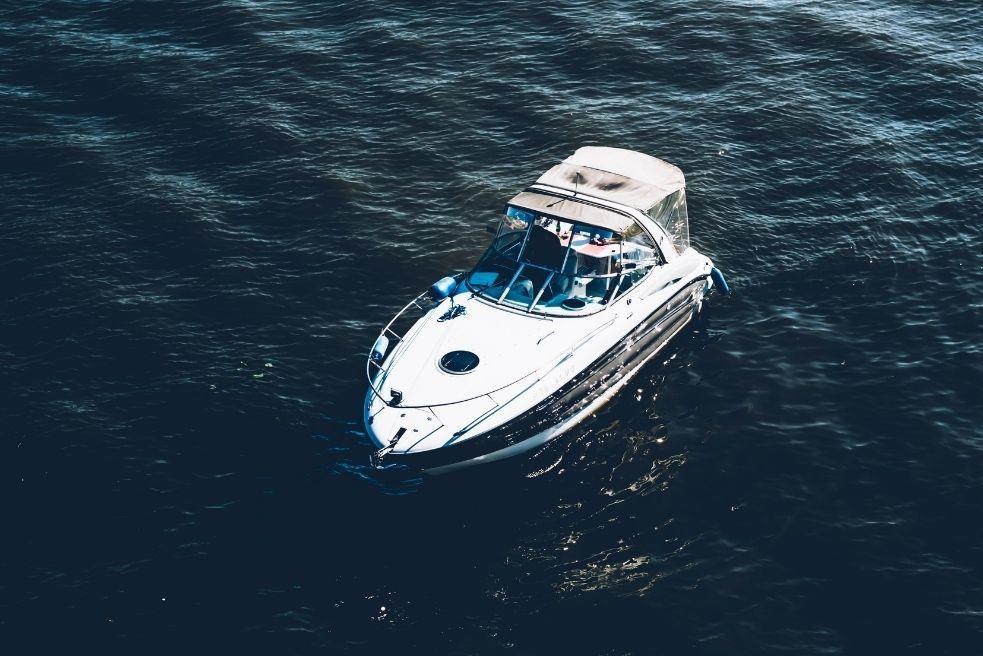
What are some Fun Things to Bring on a Boat lg ...
Oct 01, 2021
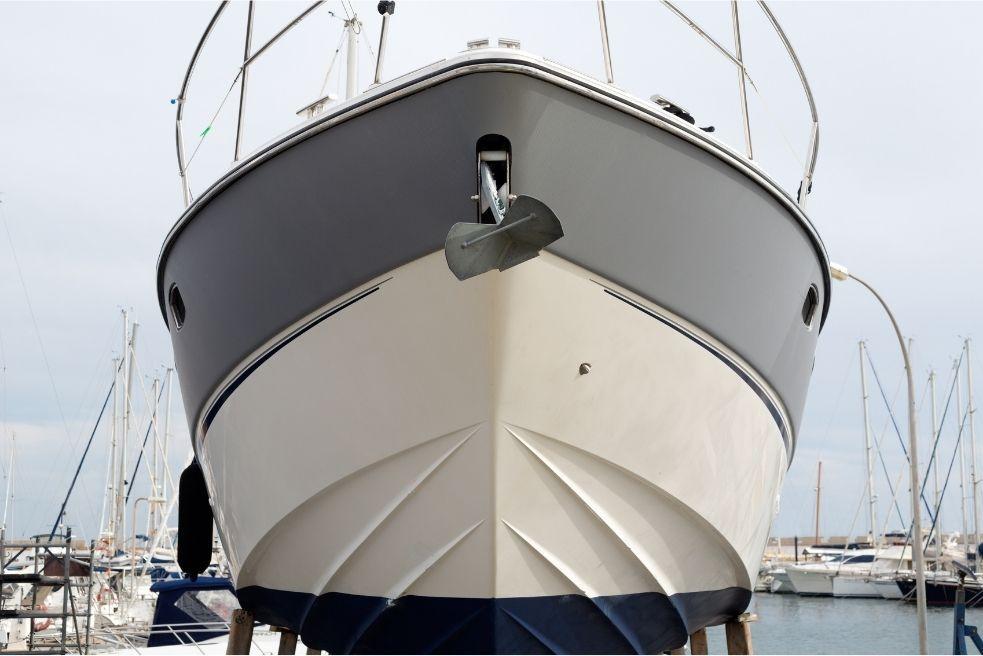
The Proper Term for the Forward End of a Boat lg ...
Sep 30, 2021
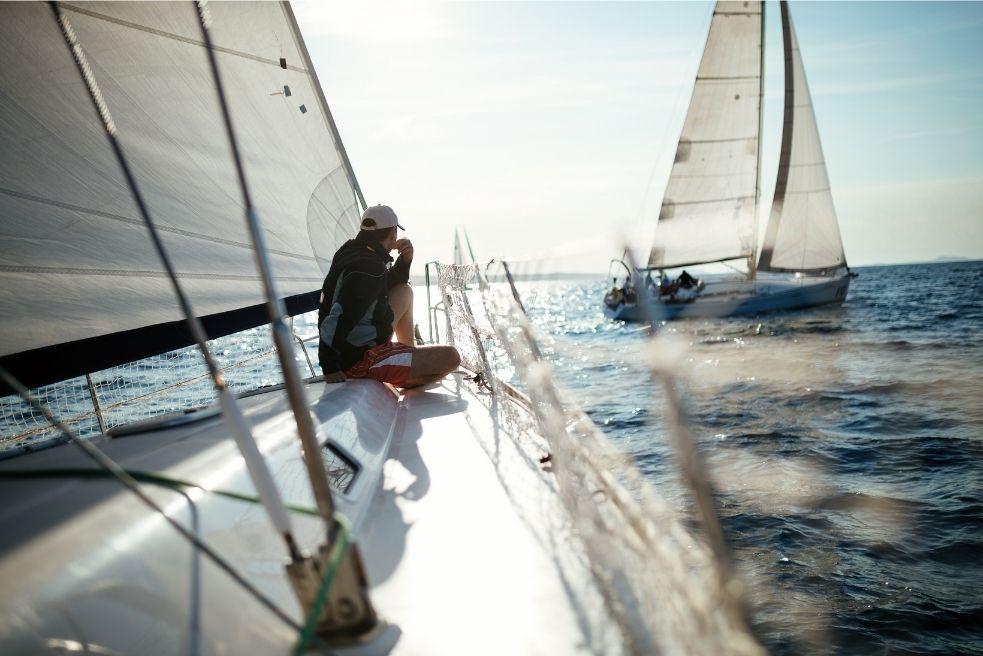
Regular Boat Maintenance Tasks You Should Always Do lg ...
Sep 17, 2021

How Fast Do Catamarans Go? 5 Examples (With Pictures)
A catamaran is generally more balanced on the water and can be faster than a multi-hull vessel.
Unless you compare them to foiling monohulls like the new America’s Cup boats that sail at over 50 knots, they are not recreational vessels.
In this article, we will look at how fast each type of catamaran will go.
Table of Contents
Here are the numbers before we dive into the details:
Average Speed For Sailing Catamarans
Catamarans can vary in size from 14 ft to over 100 ft. Catamarans can come in a wide variety of design types.
Sailing Catamarans have been attempting to make advancements over their mono-hulled counterparts.
These advancements include:
- Foils that assist with lifting the vessel out of the water.
- Stability advancements.
- Racers that can maintain their speed while out in the ocean.
3 Different Types of Sailing Catamarans:
1) sport catamarans.

One type of sailing catamaran is a sport catamaran, which is otherwise known as recreational. These are typically supposed to have a small crew and launch and land on beaches.
Sport catamarans do not normally have living quarters and are ideal for day trips. Resorts or other rental services often use these.
These can also be used for racing.
Sport vessels have been known to travel over 30 knots but can speed over 40 knots in the proper conditions.
2) Cruising Catamarans

Another type of sailing catamaran is a cruising catamaran. These often come with complete living accommodations, so they sacrifice speed over their sportier counterparts.
They can average between 9 and 10 knots, depending on the conditions. The top speed is typically around 15 knots.
It would be best if you were careful with catamarans that have living quarters. The more you weigh it down, the less speed you will have.
3) Racing Catamarans

The final type of sailing catamaran is an ocean racing catamaran.
These boats are large and can reach over 100 feet in length.
The top speed of this type of catamaran is around 45 knots.
Because of the prize money for entering these in races, much research goes into their advancement.
Average Speed Of Power Catamarans
Catamarans with power motors fill a different type of boating category.
These are commonly used when speed and smoothness are favored over space or capacity.
Because of their stability, catamarans are good vessels for combating seasickness as well as transportation. We have a separate article here with all you should know about catamarans and (how to overcome) seasickness .
On a commercial level, these can be used for ferries for both people and vehicles. They are used for short term travel, often to or from islands.
Like sailing catamarans, there are a few types of power catamarans.
1) Power Cruising Catamarans

Similar to sailing cruising catamarans, they also have power cruising catamarans. These also have living quarters and are stable while out on the water. The speed of these vessels highly depends on the motors equipped and the size of the boat itself.
Like passenger transport or ferries, catamarans have a high speed of about 40 to 70 miles per hour.
These are made to travel at great speeds to allow their commuters the shortest possible ride to their destination.
The military also utilizes power catamarans. They use power catamarans to transport military cargo. These ships are ideal because of their speed, holding capacity, and ability to venture into shallow ports.
2) Swath Catamarans

They also have small-waterplane-area twin-hull vessels. These are called SWATHs.
These differ from the average catamaran because they also have submarine-like hulls that stay completely under the water.
Due to the hulls being submerged, they are not normally affected by waves. These are used most often in the ocean as research vessels. They can also be used for certain types of yachts. Because of their stability, they are good vessels for furniture that will not require as much securing.
These often travel between 20 and 30 knots.
Some catamarans are designed for wave piercing. These are made to pierce through waves rather than sail over them, causing them to be faster. These can be used as passenger ferries, yachts, and military vessels as well.
3) Whitewater Catamarans

There are also recreational catamarans made for whitewater travel. These are sometimes called “cata-rafts.”
They are made using two inflatable hulls connected with a scaffold. These are lightweight and perfect for whitewater sports.
They are even able to be packed away in a backpack. They can take up to 20 minutes to assemble, including inflation.
They have high speeds on white water rivers and can be most compared to a canoe, kayak, whitewater raft, or other white water vessels.
Performance Characteristics Of Catamarans
Catamarans require four times the power to double their speed. A mono-hull vessel, however, would require eight times the power to double their speed.
This is because a Catamaran has less resistance in the water.
This is also good for conserving and using less energy.
Catamarans are also more stable in the water. This stability is effective at resisting heeling or capsizing. A multi-hull vessel would require four times the force to capsize as a similar-sized mono-hull vessel.
The general sailing in a catamaran is smoother and allows for activities that are not always possible on a mono-hull sailboat.
Are Catamarans Faster than Mono-Hull Vessels?
Because catamarans have less water resistance, they are generally faster than mono-hull vessels.
This is because their hulls are smaller, which means they have a smaller bow wave to fight.
A bow wave is a wave created by the displacement of water by the bow of a ship. After a certain speed, a boat has to start hauling itself over its own bow wave.
The larger hull a ship has, the larger its bow wave will be and the more power required to fight it.
Catamarans have two small and narrow hulls, so they do not have much of an issue with their bow wave. This is one reason they are usually faster than a similar-sized mono-hull vessel.
Catamarans can be between 20-30 percent faster than their monohull counterparts.
Issues with catamarans over mono-hulls are that they can take more time to turn.
How Is The Speed Measured?
Boats commonly measure speed using GPS tracking devices to measure distance traveled. Speed while sailing is measured in knots. A knot is one nautical mile per hour, which equals about 1.15 miles per hour.
How Fast Are Catamarans Compared To Other Boat Types?
- Sailing catamarans typically average about 10 knots.
- Pontoon boats average about 20 mph.
- A powerboat cruiser can average anywhere between 30 and 50 mph.
- Cigarette boats can even reach close to 90 mph in the proper conditions.
- Sailboats average between 6 and 12 mph depending on wind conditions. This includes mono-hull between 6 to 8 mph and catamarans and trimarans between 9 and 10mph
Two different factors can determine the speed of sailing ships:
1) The hull type as listed above.
Different hulls rest in the water more or less than other types. The less of the hull that is underwater, the faster it can go.
This is because the less of the hull in the water, the less drag created while sailing.
2) The length of the boat
The longer the boat, the faster it can go. Every boat has a maximum hull speed that cannot be exceeded unless the boat can plane on the water’s surface or be lifted on hydrofoils. For most boats, the longer the boat, the higher the maximum hull speed is.
Speed Vs. Comfort Considerations For Catamarans
If you are looking for a catamaran, you have a lot of options.
You can choose to prioritize speed or comfort.
After deciding to purchase a catamaran, the type of catamaran you should look at depends on where and what you are using it for.
You will want to make sure that you look at what type of water you will be traveling in, how many people you are traveling with on average, and what type of speed you hope to achieve.
One thing you will want to keep in mind before the purchase of a catamaran is storage. If you intend to store your boat in a marina, you are often charged for two slips due to the beam, or width, of a catamaran versus the standard mono-hull vessel.
Catamarans can be beneficial for those who get seasick because they offer a steadier ride and the ability to have more open air space. Because the living quarters are not inside the hull and under the water’s surface, you have more windows and visibility.
Both sailing and power catamarans are viable options. Also, sailing catamarans can come with back-up power engines for low winds or situations such as docking in a marina.
Catamarans that have twin engines can offer more control and precision than those on a mono-hull vessel. This is good for tight and busy areas or navigating marinas.
Overall, there are plenty of options for you, and they offer many benefits over their mono-hull counterparts.
Click to share...

My Cruiser Life Magazine
Fastest Catamarans for Cruising in 2023
Catamarans appeal to sailors and would-be sailors for a variety of reasons. One of those reasons is the need for speed—cats have a reputation for being faster. There are dozens of brands and tons of great boat designs that capitalize on this, and designers are constantly pushing the bounds and asking, “Really, how fast can a catamaran go?”
Performance sailing catamarans may look like your run-of-the-mill Leopard or Lagoon from a distance. But these boats are full of little tricks to boost their speeds—narrow hull designs, retractable daggerboards instead of keels, and extensive use of cutting-edge lightweight materials like carbon fiber. All of this adds up, so expect to pay double, triple, or maybe much more for a truly fast catamaran. And that means there are far fewer boats on the water, and owning one puts you in an exclusive club.
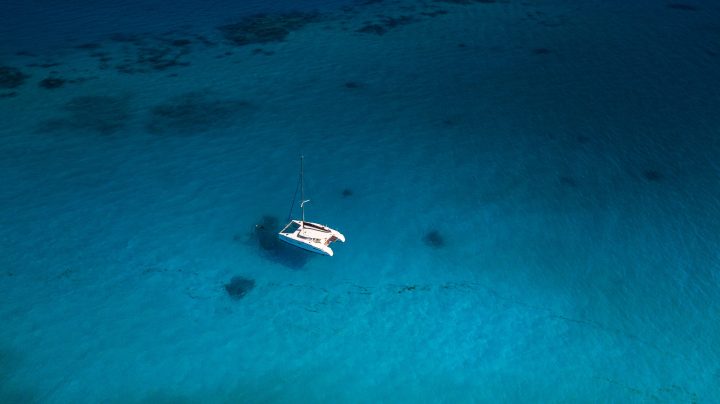
Table of Contents
Neel trimarans, what is a fast catamaran, how fast can a catamaran go, are fast catamarans the boat you’re looking for, fast catamarans faqs, top brands of fast catamarans.
Here’s a list of some of the best-known and trail-blazing fast catamaran makers. These companies are making luxury performance catamarans suited for owners who want to cruise fast. These aren’t barebones race boats built for nothing but speed. Instead, these are comfortable boats that will outperform most others in their class.
Most performance boats will be 45 feet long or more. Small catamarans don’t fall into this category, and most production liveaboard catamarans are built too heavily in order to save money.
For more than two decades, Gunboat has been setting the bar on what a performance catamaran can be. They took state-of-the-art technologies from the racing world and applied them to family-friendly cruising catamarans. The company started in the US in 2002. One of the company’s stated missions is to create boats that sail faster than the wind in anything more than 6 knots of breeze.
Since 2016, Gunboat has built top-quality boats at their La Grande-Motte, France, facility. However, they are still a boutique builder making only a handful of boats yearly. Their current offerings include the 68, 72, and 80. All boats have narrow hulls, retractable boards, high-performance sail plans, carbon fiber construction, and luxurious living accommodations.
The first hull of the Gunboat 68, CONDOR, was launched in 2019 and set out on a trans-Atlantic crossing immediately after its sea trials. The crew wrote a detailed report of the experience and the boat’s performance. CONDOR exceeded 30 knots occasionally, but average speeds were between 14 and 17 knots. Their best 24 hours saw 328 nm (an average speed of 13.7 knots).
The company motto says it all. “Life is too short to sail a slow boat.”
Outremer Catamarans is one of the original makers of French performance cats, in business since 1984. According to their website, the company has made over 300 boats since then. A large-scale production boat maker they are not. These are custom-built fast catamarans of the highest quality, made for safety, comfort, and speed. Outremer recently received much attention when popular YouTubers Sailing La Vagabonde sailed aboard an Outremer 45 for several years.
Currently, Outremer offers boats ranging from the 45 to the 5X (48 to 60 feet long). The X models (4X and 5X) are even more performance-oriented, with more extensive use of carbon fiber and a more race-inspired sail plan.
View this post on Instagram A post shared by Riley Whitelum (@riley.whitelum)
Catana is yet another French performance brand of luxury cruising catamaran. Today, Catana Group also makes Bali cruising catamarans, effectively marketing Catanas to the performance set and Bali’s to the cruising and charter set. https://www.catana.com
Presently, Catana is only making two models, the OC50 and the 53. Historically, however, Catana has made many beautiful boats. Notably, the 471 is a fast cruising catamaran that is a favorite among long-distance cruisers. On the smaller side, the 431 and even the 401 and 381 are quick and fun sailers that move better than their competition.
Catanas are easily recognizable by their daggerboards and narrow hulls with asymmetrical designs. In addition, they use a lightweight composite layup that results in a very stiff boat that weighs less than their competitors. Still, Catanas are not on the same level as an Outremer 5X or Gunboat–these are fiberglass boats that are built better than the competition and made to outperform many other boats.
HH Catamarans is Gunboat’s first real competitor in the high-end performance cat market. They started in 2012 and are part of the Hudson Yacht Group. The boats are designed by Morrelli & Melvin, a highly-regarded multihull design firm, and are built in Xiamen, China, or Cebu, Philippines.
HH has boats in their model line from 44 to 88 feet long. The company focuses on providing what owners and sailors want and are looking for, so you’ll see lots of customizability within the lineup. They include features you won’t find from a lot of builders, including lots of planned real estate for solar panels (5kW or more!), hybrid drive systems, and ocean cruising OC (keels) or sport cruising SC (daggerboard) models to pick from.
View this post on Instagram A post shared by HH Catamarans (@hh.catamarans)
Balance started in South Africa in 2013. They focus on making semi-custom, comfortable performance yachts that are strong and safe and can be easily operated single-handedly or by a couple. They are live-aboard boats that strike a balance between comfort and performance. But, compared to the current offerings from Lagoon or Leopard, it’s clear that Balance cats skew far more toward performance than others do.
Models currently range from the 442 to the 750. They’re available with daggerboards or keels and made with extensive carbon fiber and all epoxy-resin composites. According to their website, the current record speed for a Balance 482 while surfing is 28 knots. She’ll cruise all day between 8 and 14 on a reach, though. They describe the 482 as a “trend-setting circumnavigator”—the perfect boat for your sail around the world route .
Kinetic Catamarans are designed by Simonis Voogd and built in Knysna, South Africa. Like others on the list, these are semi-custom, luxury, performance cruising cats with an emphasis on speed. They have all-carbon construction, carbon spars, laminated sails, and a forward sailing cockpit deck layout.
Since they are truly semi-custom, each boat is spec-ed out to each buyer’s vision. This includes standard or racing rigs, centerboards or daggerboards, and many furnishings, layouts, and outfitting options. Kinetic currently offers 54 and 62-foot versions.
What’s better than two hulls? Three, maybe. That is, three might be better if your goal is truly fast sailing. Neel Trimarans is a new French builder attempting to capitalize on this simple fact by merging the best of all worlds—the space and liveability of a cruising catamaran with the performance, sail efficiency, and stability of an offshore-capable tri.
The company presently offers models between 43 and 65 feet. They say cruising speeds are reliably over 10 knots, with 15 to 18 knots when the breeze freshens. Compared to cats, these boats’ rigid central hulls allow for stronger rigging and better upwind performance, and the central keel allows better tracking and rudder control.
Now you’ve looked at some fast cats, you might wonder what constitutes “fast.”
You will be wowed if you’re selling your 30-foot monohull and moving up to a 50-foot cat. But if you’re coming from the world of car and plane travel, sailboats of any ilk are anything but “fast.”
The first thing to accept is that all sailboats are slow . This shocks many people who think they’d like to travel and see the world by sailboat. The marketing of these “fast cats” is everywhere, and the idea that the faster boat is safer because you can “beat the weather” is especially pervasive. No sailboat at sea can outrun a front or storm cell moving at 30 or 40 knots.
In truth, the fastest catamaran you can comfortably live aboard and cruise on will average out under 15 knots . In similar conditions, production catamarans might be doing 10 to 12. The monohull speeds of the same length might be 7 or 8 knots, and a bigger monohull with similar living space might be doing 10 or 12.
So don’t be lulled or wowed by these vessel’s maximum speed or “surfing” claims—they’re fun numbers to kick around with your dock neighbors, but what really matters is how many miles you can tick off in a day of travel.
To get more speed than this, you’ll either push the boat in ways that are not safe or comfortable at sea, or you will have to find bigger, more advanced, and even more expensive vessels. Most boats on this list are luxury liveaboard that is safe to travel the world.
But are they fast? As the old sailor saying goes, “Nothing goes to weather like a 747.” Sailing is still sailing. And sailing is a slow, slow, slow way to see the world.
Traditional monohull sailboats are displacement vessels that are limited by a few rules. As they push the water out of their way, they build up bow and stern waves. Push too much water, and the waves get bigger, pulling the vessel farther into the water. So no matter how you power it, it’s limited to hull speed. Hull speed is a factor of waterline length, width of the hull, and displacement.
Modern designs favor flat bottoms like powerboats, with the idea that they can surf and plane to get more speed. Catamarans take this even further, and with some clever design tricks , it’s possible to get a catamaran well above displacement speeds for extended runs. Of course, a lot depends on the hull type, and other factors are also at play.
Catamarans are very sensitive to weight . Their speed comes from being a lightweight boat with the ability to fly across the water, contrary to how a heavy monohull plows through it. The heavier the boat, the lower it sits in the water.
Therefore, adding weight to any catamaran will slow it down. To this end, finding a performance-oriented liveaboard catamaran less than 47 feet long is difficult. Less than this, and the narrow hulls simply can’t hold the weight of you and your stuff.
Finally, there’s the consideration of the environment you’re sailing in. The wind is obvious—they sail fastest on a broad reach. And, just like any other type of boat, they are slowest when close-hauled and on a run.
Rough seas are another of the catamaran characteristics to consider in your need for speed. Often the boat is capable of more, but the ride is rough and uncomfortable.
So you shorten sail and slow down to find the sweet spot of comfortable sailing speed—enough power to maintain a good speed without pounding your brains out and causing undo fatigue on the crew. And, of course, the rougher the conditions, the slower the boat’s performance as she slows and in the troughs and speeds “downhill.”
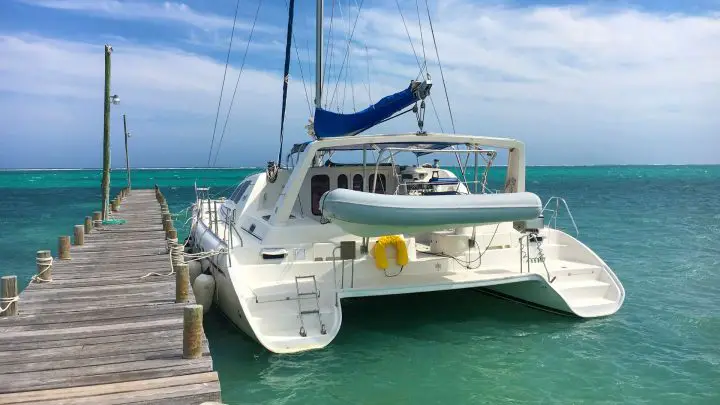
While they are faster than other vessels, that’s certainly not the only thing catamarans have going for them. Fast is a relative term, and “fast” sailing is still awfully slow. So unless you already love sailing, sailing fast might not have as much appeal as you’d expect.
Catamarans are great vessels with a lot of pluses. And these fast modern catamarans are some of the best—luxurious living space aboard comfortable, top-quality vessels.
What are the fastest catamarans?
Like those used in recent America’s Cup races, pure racing catamarans use foils to lift their hulls out of the water. Whether performance-oriented or not, regular catamarans for cruising are much slower, averaging between 10 and 15 knots. Still, they generally outperform monohull sailboats of similar lengths in most conditions, especially when sailing downwind.
How fast does a 50 foot catamaran sail?
There are many designs of catamarans, and they all sail differently. In some conditions, a pure racing catamaran may sail significantly faster than the wind speed. Most cruising catamarans, whether designated as “performance” or not, will max out around 12 to 15 knots. Momentary peak speeds may be significantly higher.
What is the fastest point of sail catamaran?
As with all sailboats, the fastest point of sail will be near a beam reach, where the apparent wind is 90 degrees from the boat’s bow. Since cats travel faster over the water, this usually means that the true wind is off the quarter, with a true wind angle of about 120 degrees off the bow.
How fast is the Gunboat 68?
Gunboat 68, hull number 1 (68-01), was launched in 2019. Immediately after sea trials, CONDOR crossed the Atlantic . The crew reported the vessel’s max speed exceeded 30 knots occasionally, with averages between 14 and 17 knots. Their best day was 328 nm, making the average speed for those 24 hours 13.7 knots (15.8 mph).
Matt has been boating around Florida for over 25 years in everything from small powerboats to large cruising catamarans. He currently lives aboard a 38-foot Cabo Rico sailboat with his wife Lucy and adventure dog Chelsea. Together, they cruise between winters in The Bahamas and summers in the Chesapeake Bay.
Leave a comment
Your email address will not be published. Required fields are marked *
Save my name, email, and website in this browser for the next time I comment.


Catamaran Hull Speed Calculator For Beginners (Table and Free Spreadsheet)

As an Amazon Associate, we earn from qualifying purchases. We may also earn commissions if you purchase products from other retailers after clicking on a link from our site.
Speed is important, it can get you out of harm’s way, and it makes sailing much more fun, but figuring out how fast a catamaran will be able to sail can be tricky. One important aspect is to understand maximum hull speed.
In this article, I have calculated different hull speeds for different lengths of boats; this includes both monohulls and catamarans but focuses on the latter. Here is the catamaran maximum hull speed table:
Table of Contents
Catamaran Max Hull Speed Calculator Table
Table explanation.
- Length on the waterline (L.W.L.): Length of the boat when measured on the waterline, not to be confused with length overall (L.O.A.), which is the boat’s total length (above the waterline) including bowsprit, etc.
- Displacement max hull speed: The max speed of a boat whose L.W.L doesn’t change when underway and where the vessel’s bow wave is the limiting speed factor.
- Semi/Light Displacement or Semi planing hulls speed: A boat where the bow waves speed limiting factors can be partially overcome and therefore exceed the displacement hull speed. These hulls usually overcome hull speed by 10-30% .
How to use the Catamaran Hulls Speed Table
- Choose your length on waterline in the left-most column, either in feet or meter.
- Continue reading to your right and stop either at “Displacement hulls speed” or continue to “10,20, or 30%”, depending on your estimated hull efficiency. This will be your calculated maximum hull speed for a semi-displacement catamaran.
The Formula
First of all, we need to know the maximum hull speed for a displacement hull, and from that number, we will be able to calculate how much faster the semi-planing (or semi-displacement) hull will be. This is the formula for Maximum Hull Speed on a displacement boat:
Now we need to add the increased efficiency (loss of drag) of a semi-displacement hull, usually, this is somewhere between a 10-30% increase.
Note: “1.3” is the increase in efficiency, if you believe you are on the lower end of the scale this would be 1.2 or 1.1.
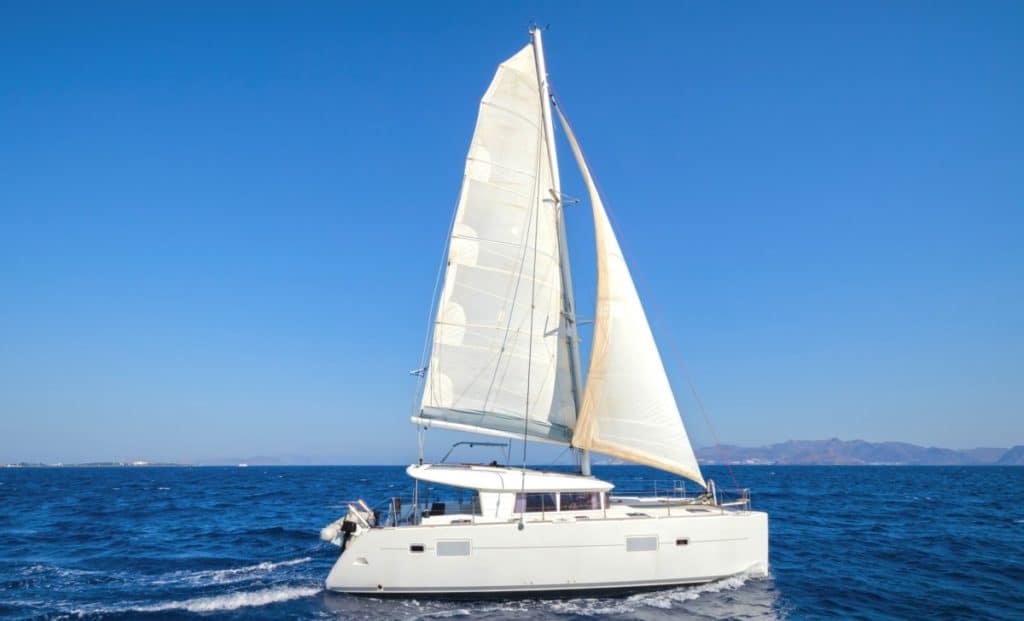
How to Exceed Hull Speed
This calculator offers a theoretical perspective, but many other factors such as sail plan, weight, and sailor skill, of course, have a profound impact on speed. As we have seen, a semi-displacement hull can exceed maximum hull speed, but we can also see that it isn’t by much. The next step is to reduce drag even further by utilizing a planning hull.

Catamaran Hull Speed Spreadsheet
If you want more info, calculate other lengths, or see the speeds in Km/h or Mph then I suggest you check out this free spreadsheet.
Catamaran Freedom Hull Speed Calculator
Note: If you want your own copy just click, File->make a copy.
Common Questions About Catamaran Hull Design
Below I will answer some of the questions I receive concerning catamaran hull design. The list will be updated as relevant questions come in.
Is a Catamaran a Planing hull?
As we have discussed above, a catamaran can definitely have a semi-planing hull, but can it be designed in a fully planing configuration as well?
Catamarans can be configured as planing hulls, although most sailing catamarans are set up as either semi-planing or hydrofoil. Due to the high speeds needed to get a boat to planing speed, this is only possible on racing sailboats or motor-powered catamarans such as high-speed ferries.
Owner of CatamaranFreedom.com. A minimalist that has lived in a caravan in Sweden, 35ft Monohull in the Bahamas, and right now in his self-built Van. He just started the next adventure, to circumnavigate the world on a Catamaran!
Leave a Reply Cancel reply
Your email address will not be published. Required fields are marked *
Save my name and email in this browser for the next time I comment.
Recent Posts
Must-Have Boat Gear for Catamaran Sailors!
Sailing is probably the most gear-intensive activity I've ever done; there are so many decisions to be made about what gear to buy now, for tomorrow, and what to definitely never buy. The gear on...
6 Best Trailerable Trimarans For Bluewater and Coastal Sailing
Having a boat costs a lot of money, even when you are not using it, marina fees, etc. And once it is in the water most sailors never go very far from their "home marina" and sailing will be somewhat...


How Fast Can a Catamaran Sail?

What is a catamaran? This question is asked by many people, especially those who have never seen this type of boat before. A catamaran is a type of sailboat that has a few key differences from regular sailboats and boats. In this blog post, we will discuss the basics of catamarans and how they compare to both each other and other boats.
What is a catamaran and how does it sail?
A catamaran is a type of sailboat that is characterized by having two hulls, or pontoons, attached to one another. Catamarans are often used for pleasure cruising and racing and are able to reach high speeds due to their design.
It is powered by sails and is mainly used for recreation. Catamarans are stable and can sail in shallow waters. They are also faster than monohull vessels because they have less drag. The speed of a catamaran heavily depends on the wind conditions and the size of the vessel.
How fast can a catamaran sail and what are the speeds for different types of catamarans?
As we said earlier, the speed of a catamaran depends on the wind conditions and the size of the boat. Most catamarans can sail at speeds between 15 and 30 knots. Some racing catamarans can reach speeds of up to 30 knots. Of course, there are always exceptions to the rule and some catamarans can sail faster or slower depending on the conditions.
However, the average cruising speed for a catamaran is around 12 knots. This means that it would take approximately five hours to travel 60 nautical miles.
Factors that affect a catamaran’s speed
There are a few factors that can affect the speed of a catamaran. The first is the wind. If the wind is blowing against the boat, it will slow it down. The second factor is the size of the boat. A larger catamaran will usually be slower than a smaller one. The third factor is the type of sails that are being used. Some sails are designed to go faster in certain conditions than others.
There are a variety of types of catamarans, such as ultralight, cruisers, and sport catamarans which all have different amenities. Catamarans as a whole are built to pierce through waves making them a fantastic boat for ocean waters. Depending on what type of catamaran you’re in, there will be a difference in the performance of each.
The best wind conditions for sailing a catamaran
The best wind conditions for sailing a catamaran are when the wind is blowing from behind the boat. This is because the sails will be able to catch more wind and the boat will be pushed forward. When the wind is blowing from the side, it can create drag and slow the boat down. If the wind is too strong, it can also cause the boat to tip over.
The best way to sail in different types of winds is to adjust the sails accordingly. For example, if it is windy, you would want to reef, or lower, the sails so that they are not catching as much wind.
Fun Activities for Catamaran Rides
A catamaran is a great way to get out and explore when you’re near the beach. Whether you have a friend with a boat or want to take a tour, it’s guaranteed to be a fun and unique experience.
If you ever find yourself on the Big Island of Hawaii, there are a variety of businesses that can take you out on a catamaran for different fun activities. We at Kona Style offer a variety of exciting outdoor activities, such as a manta ray night snorkeling trip , or a simple afternoon snorkel and sail along the Hawaiian coast. You have a bunch of different snorkeling tour options when you book with Kona Style.
Whatever you’re looking for, someone on the island can offer it. Make sure to do your research and figure out what catamaran sailing adventure is best for you.
Time to Sail
Now that you know what a catamaran is and what they can do out in the water – you can start planning your sailing adventure. These versatile boats can accommodate pretty much any activity you have planned for the water – from a relaxing cruise in the sunset to snorkeling late at night with the manta rays.
We at Kona Style offer a variety of ways to get out and experience the power of catamaran and explore the Hawaiian waters. Call us now at (808) 936-1323 or email us at [email protected] with any questions you may have about your vacation. We hope you’ve enjoyed this blog post.

KEALAKEKUA SNORKEL & SAIL

SUNSET & MANTA RAY SNORKEL

AFTERNOON MARINE ADVENTURE
How SailGP’s foiling F50 catamarans sail so much faster than the wind

Arguably the most technologically advanced sailboats on the planet right now, the one-design SailGP F50 foiling catamarans are capable of breathtaking speeds – at times, reaching four times the velocity of the wind that drives them. But how do they do it?
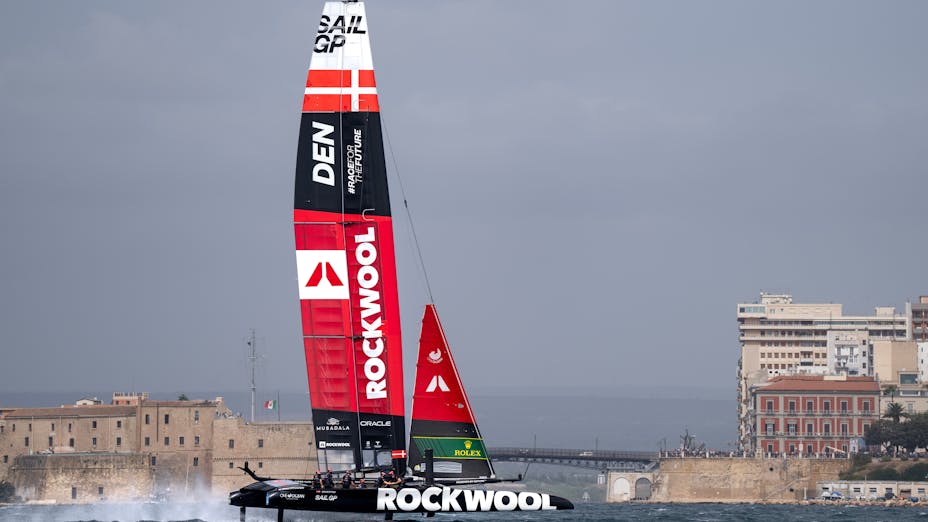
Beating the balloon

Bending the laws of physics

Faster and faster

Beneath The Surface
Watch on youtube.
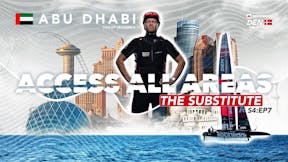
Access All Areas
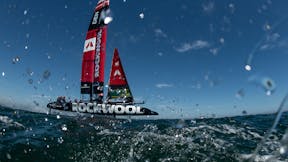
Want to learn more about SailGP?
Meet the denmark sailgp team, find all the latest news, go beneath the surface of sailgp, sailing terms, go beneath the surface.
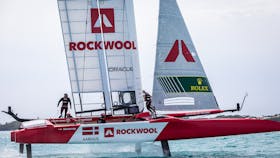
How the world’s fastest sail racing boats fly above the water
Tune in to SailGP’s landmark Season 2 opener in Bermuda at the end of the month, and you’d be forgiven for thinking that your eyes are deceiving you.

The Beneath The Surface show
We go Beneath The Surface of SailGP's iconic host cities, set a spotlight on great projects and curious mind and catch all the lastest with the Denmark SailGP Team. Join us as we travel the world and explore how innovation and science is helping solve the world's biggest challenges!
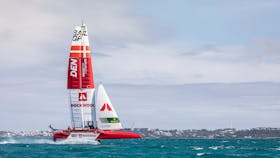
This is how SailGP's NASA-inspired wings make the F50 boats fly
Some may say the foils, which help the boats to fly above the water. Others may claim it’s the platform – that’s the two, catamaran hulls and the trampoline that connects them.
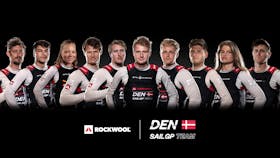
ROCKWOOL Denmark SailGP Team
The official home of the ROCKWOOL Denmark SailGP Team. Meet the team, read all the latest stories and explore a world of exciting content.

ROCKWOOL Group

The Ultimate Guide to Choosing Between a Sailboat or Catamaran for Your Sailing Adventures
C hoosing between a sailboat and a catamaran for your sailing adventures is a significant decision that depends on various factors, including your sailing preferences, experience level, budget, and intended use. Here's an ultimate guide to help you make an informed decision:
1. Sailing Experience:
- Sailboats: Typically require more skill and experience to handle, especially in adverse weather conditions. Ideal for sailors who enjoy the traditional feel of sailing and are willing to invest time in learning and mastering the art.
- Catamarans: Easier to handle, making them suitable for beginners. The dual-hull design provides stability, reducing the learning curve for those new to sailing.
2. Space and Comfort:
- Sailboats: Generally have a narrower beam and less living space. However, some sailboats may offer comfortable cabins and amenities.
- Catamarans: Wider beam creates more living space. Catamarans often have multiple cabins, spacious saloons, and expansive deck areas, providing a more comfortable living experience.
3. Stability:
- Sailboats: Monohulls can heel (lean) while sailing, which some sailors enjoy for the thrill but can be discomforting for others.
- Catamarans: Greater stability due to the dual hulls, providing a more level sailing experience. Reduced heeling makes catamarans suitable for those prone to seasickness.
4. Performance:
- Sailboats: Known for their upwind performance and ability to sail close to the wind. Some sailors appreciate the challenge of optimizing sail trim for efficiency.
- Catamarans: Faster on a reach and downwind due to their wide beam. However, they may not point as high into the wind as monohulls.
- Sailboats: Typically have a deeper draft, limiting access to shallow anchorages and requiring deeper marina berths.
- Catamarans: Shallow draft allows access to shallower waters and secluded anchorages, providing more flexibility in cruising destinations.
- Sailboats: Generally more affordable upfront, with a wide range of options available to fit different budgets.
- Catamarans: Often more expensive upfront due to their size and design. However, maintenance costs may be comparable or even lower in some cases.
7. Mooring and Docking:
- Sailboats: Easier to find slips and moorings in marinas designed for monohulls.
- Catamarans: Require wider slips and may have limited availability in certain marinas, especially in crowded anchorages.
8. Intended Use:
- Sailboats: Ideal for traditional sailors who enjoy the art of sailing, racing enthusiasts, or those on a tighter budget.
- Catamarans: Suited for those prioritizing comfort, stability, and spacious living areas, especially for long-term cruising and chartering.
9. Resale Value:
- Sailboats: Generally have a more established resale market, with a wider range of buyers.
- Catamarans: Growing in popularity, and well-maintained catamarans often retain their value.
10. Personal Preference:
- Consider your personal preferences, the type of sailing you plan to do, and the kind of lifestyle you want aboard your vessel.
In conclusion, both sailboats and catamarans have their advantages and disadvantages. Your decision should be based on your individual preferences, experience level, budget, and intended use. If possible, charter both types of vessels to experience firsthand how they handle and to help make a more informed decision based on your own preferences and needs.
The post The Ultimate Guide to Choosing Between a Sailboat or Catamaran for Your Sailing Adventures appeared first on Things That Make People Go Aww .

Yachting World
- Digital Edition

America’s Cup boats: How they work and why they’re unique
- Toby Heppell
- February 5, 2021
The America's Cup boats to be used on the 2021 edition of the event are unlike anything we have seen before. They might be officially sailing craft but they behave in some remarkable ways.

The AC75s, the America’s Cup boats currently racing in the Prada Cup and that will be used for next month’s Cup match showdown, are arguably the most radical boat the America’s Cup has ever seen.
The America’s Cup is, fundamentally, a design competition, and successive America’s Cups have featured the most extreme yachts yet – for their time – ever since the first race in 1851 .
However, the foiling boats we have seen in the last three editions of America’s Cup racing (the AC72 and AC50 catamarans, and now the AC75 monohulls ) do represent a new direction for the highest level of sailing.
There are plenty who argue that this technology is so far beyond the bounds of what most people consider sailing as to be an entirely different sport. Equally, there are those who believe this is simply a continuation of the development that the America’s Cup has always pushed to the fore, from Bermudan rigs, to composite materials, winged keels, and everything in between.
Good arguments can be made either way and foiling in the world’s oldest sporting trophy will always be a subjective and controversial topic. But one thing is certain: the current America’s Cup boats, the AC75s, are unlike anything seen before and are showcasing to the world just what is possible under sail power alone.
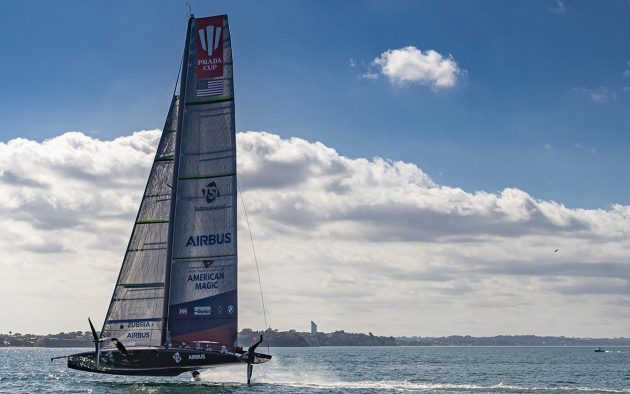
American Magic hit an impressive 53.3 knots on their final weekend of racing. Photo: COR 36/Studio Borlenghi
1 Unimaginable speed
In their final race before being knocked out of the competition , American Magic’s Patriot registered a top speed of 53.3 knots during a bear away.
Topping the 50-knot barrier used to be the preserve of extreme speed record craft and kiteboarders. A World Speed Sailing Record was set in 2009 of 51.36 knots by Alain Thebault in his early foiling trimaran, Hydroptere , and was bested in 2010 by kite boarder, Alexandre Caizergues who managed 54.10 knots.
O nly one craft has ever topped 60-knots, the asymmetric Vestas Sail Rocket , which was designed for straight line speed only and could no more get around an America’s Cup course than cross an ocean. Such records are set by sailing an average speed over the course of 500m, usually over a perfectly straight, flat course in optimum conditions.
America’s Cup class yachts, designed to sail windward/leeward courses around marks, are now hitting speeds that just over a decade ago were the preserve of specialist record attempts, while mid-race.
Perhaps even more impressive, in the right conditions when racing we have seen some boats managing 40 knots of boatspeed upwind in around 17 knots of wind. That is simply unheard of in performance terms and almost unimaginable just three or so years ago.

Photo: COR 36/Studio Borlenghi
2 A storm onboard America’s Cup boats
Related to the speeds the boats are sailing through the water, particularly upwind, is the wind speeds the sailors will feel on deck.
When sailing, the forward motion affects the wind we experience onboard, known as apparent wind. The oft’ trotted out explanation of how apparent wind works is to imagine driving your car at 50mph. Roll down the window and stick your hand out of it and there will be 50mph of wind hitting your hand from the direction your car is travelling.
Article continues below…

America’s Cup: Schedule and how to follow the racing
The teams are there, the boats are there, and finally after two months of AC75 racing in Auckland, for the…

America’s Cup Challengers: The view from Auckland
Reversing the odds over the space of four weeks where the worst performing America’s Cup team became the best and…
So when an AC75 is sailing upwind in 18 knots of breeze at a boatspeed of 40 knots, the crew on deck will be experiencing 40 knots of wind over the decks plus a percentage of the true wind speed – depending on their angle to the wind.
The AC75 crews might be sailing in only 18 knots of breeze – what would feel like a decent summer breeze on any other boat – but they experience winds of around 50 knots.
To put that into context, that is a storm force 10 on the Beaufort scale!

Once up on the foil, everything to windward of the leeward foil generates righting moment. Photo: COR 36/Studio Borlenghi
3 Righting moment changes
The single most radical development of the AC75 is to take a 75ft ‘keelboat’, but put no keel on it whatsoever.
When the America’s Cup Defender and the Challenger of Record, Emirates Team New Zealand and Luna Rossa Prada Pirelli respectively, announced the 36th America’s Cup would be sailed in 75ft monohulls, conventional wisdom had it that the boats would look something like a TP52 or a Maxi72 – both impressively high performance keelboats.
By doing away with the keel entirely, the design is now like nothing we have ever seen, particularly when it comes to how dynamic the power transition is between foiling and not foiling.
The boats are designed to foil on the leeward foil, with the windward one raised to help increase righting moment: to help balance the boat. This means that when the AC75 is not foiling they are extremely tippy – much more so than most other boats of the same size.
Essentially, when the wind catches the sails, the boat wants to fall over as there is too much sail area for the amount of weight underneath the boat – something a lead keel usually counters on a yacht or keelboat.
Once the boat is up and on the foils, however, that all changes, as everything to windward of the single foil in the water balances the sails. That means, the hull, the crew weight, the sail and rig weight, and the windward foil, all work to counter the sails.
What all this means is that the boats go from being extremely tippy, to hugely powerful in just the few seconds it takes to get up on the foil. “The [AC75s] are really very tippy pre-foiling and then they go through the transition where they will need to build significant power. Then immediately [once they lift off] you have more stability than, well, take your pick, but certainly more righting moment than something like a Volvo 70 with a big canting keel.
“That change all happens in a very short space of time,” explained Burns Fallow of North Sails, who was one of the team who developed the soft wing concept back when the concept was revealed.

With lift created to windward by the foils, it is possible that the boats can sail diagonally to windward. Photo: COR 36/Studio Borlenghi
4 America’s Cup boats may not be heading where they point
With the AC75 sailing on its foil, drag is dramatically reduced, vast amounts of power can be generated and so speeds rapidly increase. But the foils can serve another purpose too.
In order to be able to lift each foil out of the water, the foil arms must be able to be raised and lowered. Hence the foil wings, which sit at the bottom of the foil arms (and are usually a T or Y shape), do not always sit perpendicular to the water surface and the AC75s often sail with them canted over to something nearer 45º to the surface.
The further out the leeward foil arm is canted – essentially more raised – the closer the AC75 flies to surface and, crucially, the more righting moment is generated as the hull and rest of the boat gets further from the lifting surface of the foil.
There is another positive to this: as the lifting foil is angled, it produces lift to windward, which can force the boat more towards the wind than the angle it is sailing.
Due to this negative leeway (as it is known when a foil creates lift to windward) the boat can be pointing at a compass heading of say 180º but in fact will be sailing at eg 177º as the foil pushes the boat sideways and to weather, essentially sailing to windward somewhat diagonally.

5 The foils are heavy. Very heavy.
As the foils work to provide stability to the boat (when it is stationary both foils are dropped all the way down to stop it tipping over) and to provide massive amounts of righting moment, they are incredibly heavy.
A pair of foil wings and flaps (excluding the one-design foil arm which attaches them to the boat and lifts them up and down) weigh 1842kg. To put that into perspective, the entire boat itself with all equipment (but without the crew) weighs between 6508kg and 6538kg. So the foil wings at the base of the foil arms are nearly ⅓ of the total weight of the boat.
It is partly due to this that you will see some teams with bulbs on their foils. If you decide to go for a skinny foil wing (which would be low drag and so faster) then there will not be enough volume to cram sufficient material in to make the foil weigh enough. So some teams have decided to add a bulb in order to make it weigh enough but to also keep a less draggy, slimmer foil shape.
6 Sails can invert at the head

As with everything on the AC75, the mainsail is a relatively new concept. It consists of two mainsails which are attached to both corners of a D-shaped mast tube. This has the effect of creating a profile similar to a wing.
It is well established that solid wing sails are more efficient at generating power than a soft sail and for this reason solid wings were used in both the America’s Cup in 2013 and 2017. But there are drawbacks with a wing: they cannot be lowered if something goes wrong and require a significant amount of manpower and a crane to put it on or take it off a boat.
One reason a wing makes for such a powerful sail is that the shape can be manipulated from top to bottom fairly easily with the right controls. With the AC75 the designers wanted a sail that could have some of this manipulation, produce similar power but could also be dropped while out on the water. The twin skin, ‘soft wing’ is what they came up with for this class of America’s Cup boat.
In addition to the usual sail controls, within the rules, the teams are allowed to develop systems for controlling the top 2m of the mainsail and the bottom 1.5m.
What this means is that the teams are able to manipulate their mainsail in a number of different ways to develop power and control where that power is produced in the sail. But it also means that they have the ability to invert the head of the sail.
Doing this effectively means ‘tacking’ the top of the sail while the rest of the sail is in its usual shape. The advantage here is that instead of trying to tip the boat to leeward, the very top of the sail will be trying to push the boat upright and so creating even more righting moment. The disadvantage is that it would come at the cost of increased aerodynamic drag.
We know that a number of America’s Cup teams are able to do this, though whether it is effective is another question and it is very hard to spot this technique being used while the boats are racing at lightning speeds.

Photo: Emirates Team New Zealand
7 An America’s Cup boat generates lots of data
A new America’s Cup boat is a vastly complex bit of kit. Each team has incredibly powerful Computational Fluid Dynamics (CFD) software packages and simulators in order to try to understand the various gains and losses.
To make these simulators and computer projections as accurate as possible each team has been getting as much data as they can over their three year development cycle.
In the case of this America’s Cup it does seem the development process is genuinely getting closer to Formula 1 (albeit with smaller budgets than a modern F1 team has behind them).
INEOS Team UK have been able to work alongside the all powerful Mercedes F1 team (both of who are backed by INEOS) and have been open about how much this has helped their development process. They even have some Mercedes staff out with the team in Auckland assessing their data.
“It’s really similar to F1,” explains Mercedes Applied Science Principal Engineer Thomas Batch who has 11 F1 titles to his name and is with INEOS in Auckland. “Certainly in this campaign the technology is close to what we have in F1.
“In terms of raw sensors on the boat you are probably talking in the 100s but then we take that and we make that into mass channels and additional analysis with computational versions of those channels that we then analyse and get into in more detail. So you are looking at 1000s of plots that we can delve into [per race or training session].
“That level of data analysis and then feedback with the sailors is very similar to working with an [F1] driver.”
If you enjoyed this….
Yachting World is the world’s leading magazine for bluewater cruisers and offshore sailors. Every month we have inspirational adventures and practical features to help you realise your sailing dreams. Build your knowledge with a subscription delivered to your door. See our latest offers and save at least 30% off the cover price.
Fleet Week NYC 2024: See massive warships sailing around New York to honor service members

Fleet Week is setting sail in New York City from May 21 to May 27 to honor those who serve and protect the United States seas.
Nearly 3,000 Sailors, Marines and Coast Guardsmen will be honored at the Hudson River during Fleet Week, which began in 1988.
"Fleet Week New York, now in its 36th year, is a time-honored tradition for the Navy, Marine Corps and Coast team to visit New York City over the Memorial Day weekend,” Director of Public Affairs and Fleet Week New York, Beth Baker, said in a statement to USA TODAY.
“The week-long event provides us an opportunity for the citizens of New York City and the surrounding area to meet their service members and see firsthand the latest capabilities of today's maritime services," Baker said in the statement.
At the Hudson River on Wednesday morning, crew members were getting ready to kickoff the annual event.
Here are some of the things you should know about New York’s Fleet Week:
Fleet Week schedule
Fleet Week will run from May 22 until May 28. See below for information about tours.
How can I watch the celebration in New York?
USA TODAY provided a livestream of Fleet Week in New York City. Watch a replay above.
Photos and videos show the kickoff to Fleet Week 2024
Fleet week tours.
People can also participate in a public tour of ships including the U.S. Navy amphibious assault ship USS Bataan (LHD 5), a Baden-Württemberg-class frigate and a German Berlin-class replenishment ship. You'll just need to have a valid ID.
A full schedule of the tours can be found on the Navy Region Mid-Atlantic's website .
Ahjané Forbes is a reporter on the National Trending Team at USA TODAY. Ahjané covers breaking news, car recalls, crime, health, lottery and public policy stories. Email her at [email protected] . Follow her on Instagram , Threads and X (Twitter) .

How Fast Do Racing Sailboats Go?

Last Updated by
Jacob Collier
August 30, 2022
Speed thrills, and in a sailboat, it thrills even more. Sailboat racers like to push their boats to the limit. But just how fast do racing sailboats go?
Sailboats come in a variety of shapes and sizes. If you are a speed enthusiast, you must wonder about the maximum speeds of different sailboats and if larger sailboats can go faster than smaller ones.
Racing sailboats usually skim over the water at around 15 to 20 knots. For comparison, the average speed of a traditional sailboat is only around 5 to 8 knots. Some custom-designed boats can reach record-breaking speeds of up to 50 or more knots.
Since sailboats don't rely on internal power for speed, many factors determine the speed of a sailboat, and every sailboat has different top speeds.
Experienced sailboat sailors believe that several factors influence the top speed. The size and shape of the boat, sails, and skill level all play a crucial role in determining the speed of a sailboat. Even more than the internal factors, external factors such as the waves and the wind can greatly boost or hinder sailboat speed.
Table of contents
What Influences Sailboat Speed
Sailboats have different shapes and sizes, and different sailboats can reach different speeds. There are many internal factors, such as those related directly to the boat, and external factors, such as weather, ocean currents, etc., that influence the speed of a sailboat.
Boat Size and Length
The most crucial thing that plays a role in speed is the sailboat's length and overall surface area. What does size have to do with speed, you ask? For a sailboat to go fast, you need to maximize the propulsion by the wind and keep drag and resistive forces to a minimum.
As the sailboat moves through the water, it generates waves. One wave that is created among others constantly rides with the boat. It has its peak just in front of the bow, while its trough is at the stern. If this wave is long enough, it can act as a wall of water to the boat.
The aerodynamic shape of the bow is designed to push up and rise above this wave. This allows the boat to lift the bow out of the water and rise above the water surface. As the bow rises, the stern gets pushed down into the water. This reduces the drag and also allows the boat to glide above waves.
But this wall of water creates resistance for the boat, and the sailboat requires power and momentum to break through this resistance. A larger sailboat has more momentum, which allows it to break through the barrier easily. This makes it possible for the larger boat to go faster.
You might think that a smaller boat is lighter and will offer less resistance and drag. Yes, this is true, but a smaller boat generates multiple small waves, which offer more resistance. Lightweight boats are also more susceptible to wind shear and tend to veer off course.
Different boats have different hull designs. The hulls are designed to be narrow and precisely engineered for racing sailboats to offer minimum resistance. It makes sense that a boat with a hull like a bathtub will not even come close to a sailboat with a narrow and streamlined hull.
The hull design also plays a vital role in the speed of a sailboat. A hull built for speed will have a straight line from the lowest point to the aft, and the aft will be wider. This design makes the boat stable and allows it to reach higher speeds.
On the other hand, a boat with multiple curves on the hull and a narrow transom will not be as fast. The reason for the hull playing a vital role in speed is simple. It needs to cut through the water to ensure the least resistance.
There are three major hull types for sailboats.
As the name implies, monohull sailboats comprise one hull. These boats offer high levels of stability, making them extremely difficult to capsize. The hull is designed to cut through the water, which keeps the boat stable, and allows it to pick up speed. The hull can be raised out of the water if you need to go faster. Monohull boats are traditionally designed to sail below 10 knots.
A catamaran, more commonly known as a cat, comprises two hulls running side by side. These hulls are similar in size. Cats are significantly faster than monohulls and can reach between 15 knots and even go more than 50 knots.
The Trimaran is also known as the double outrigger. Trimarans have three hulls, which means they offer more stability and are extremely buoyant. The three hulls allow the boat to gain speed because it rises above the water surface with little resistance. Tamarans can reach speeds of up to 20 knots.
Skill Level
Sailboat racing has become a highly competitive sport. When it comes to speedboats, you can use engine power to hit maximum speeds, but it takes a lot of skill and experience to get your sailboat to move at speeds three times the wind.
The amount of training, skill, and experience you have is crucial to how fast your racing sailboat goes.
The only propulsion you have on a sailboat is the wind. With a good wind in your sails, your boat will move much faster. Both types of winds, apparent and true, play a crucial role in your sailboat's performance. The stronger the true winds, the faster the boat will move.
Waves play a crucial role in your boat's performance. They influence the speed and determine your and your vessel's safety. Calm and serene water can quickly turn aggressive and furious without prior notice.
If the waves are strong enough, and you don't know how to navigate through them, they can easily capsize your boat. Depending on their direction, they can also significantly increase or decrease the speed of your sailboat.
When the medium you are running on, water, is moving fast, your boat will experience a significant increase in speed. You can think of it as walking on a travelator. If you are walking in the same direction as the travelator, your speed will be increased. But, if you decide to walk in the opposite direction to the travelator, you will look weird and will be considerably slowed down.
Going Faster Than The Wind
Two types of winds influence the speed of a sailboat; these are true wind and apparent wind. To understand these better, let us look at an example. Imagine you are riding a motorcycle when there is no wind. As you pick up speed, you begin to feel the wind in your face; this is called apparent wind. It is the air pressure you feel while moving through the still air.
Say you are riding at 20 mph on your motorcycle; the wind you will feel on yourself will be 20 mph. Now let's add true wind to the equation. Say the wind is naturally blowing at 20 mph, and you are heading in the same direction as the wind. The wind pushing you and the apparent wind will cancel each other out if they are perfectly reverse-parallel to one another.
The sails experience the same apparent wind you felt while on the motorcycle when you are on the sailboat. The sails are designed to put the apparent wind to use and help propel the boat further. As you increase your speed, the apparent wind grows stronger, which leads to more wind in your sails.
How Fast do Racing Sailboats Go?
Now that we know the factors that influence sailboat speed, let us look at how fast racing sailboats go. If you are a traditional sailboat sailor, you will be lucky if you can hit 10 knots. But with racing sailboats, you can achieve over 15 knots, and many racing sailboats can hit 20 knots. The fastest anyone has ever achieved on a sailboat is 65.45 knots , a world record.
Related Articles
Positions on a Racing Sailboat
How Fast Do Catamarans Go?
Are Small Sailboats or Big Sailboats Faster?
Born into a family of sailing enthusiasts, words like “ballast” and “jibing” were often a part of dinner conversations. These days Jacob sails a Hallberg-Rassy 44, having covered almost 6000 NM. While he’s made several voyages, his favorite one is the trip from California to Hawaii as it was his first fully independent voyage.
by this author
Most Recent

What Does "Sailing By The Lee" Mean?
Daniel Wade
October 3, 2023

The Best Sailing Schools And Programs: Reviews & Ratings
September 26, 2023
Important Legal Info
Lifeofsailing.com is a participant in the Amazon Services LLC Associates Program, an affiliate advertising program designed to provide a means for sites to earn advertising fees by advertising and linking to Amazon. This site also participates in other affiliate programs and is compensated for referring traffic and business to these companies.
Similar Posts

How To Choose The Right Sailing Instructor
August 16, 2023

Basics Of Sailboat Racing Explained
May 29, 2023

Cost To Sail Around The World
May 16, 2023
Popular Posts

Best Liveaboard Catamaran Sailboats
December 28, 2023

Can a Novice Sail Around the World?
Elizabeth O'Malley
June 15, 2022

4 Best Electric Outboard Motors

How Long Did It Take The Vikings To Sail To England?

10 Best Sailboat Brands (And Why)
December 20, 2023

7 Best Places To Liveaboard A Sailboat
Get the best sailing content.
Top Rated Posts
Lifeofsailing.com is a participant in the Amazon Services LLC Associates Program, an affiliate advertising program designed to provide a means for sites to earn advertising fees by advertising and linking to Amazon. This site also participates in other affiliate programs and is compensated for referring traffic and business to these companies. (866) 342-SAIL
© 2024 Life of Sailing Email: [email protected] Address: 11816 Inwood Rd #3024 Dallas, TX 75244 Disclaimer Privacy Policy

IMAGES
VIDEO
COMMENTS
August 30, 2022. Catamarans are known for their speed, and some vessels are fast enough to break world sailing speed records. Catamarans can go between 15 and 30 knots, with the fastest achieving speeds well in excess of 60 knots. Sailing catamarans are sometimes twice as fast as monohulls and cut through the water with greater efficiency.
Some of the fastest cruising catamarans include the Gunboat 68 (35 knots), Outremer 45 (25 knots), ORC50 (25 knots), FastCat 435 (20 knots), TS 42 (35 knots), and Lagoon 440 (20 knots). Yet, there are many more cats that can reach 35 knots safely. If you are interested in knowing about the fastest cruising catamarans, I have you covered.
How Fast Do Catamarans Sail? - The Bottom Line. Bear in mind that not all catamarans are created equal. In other words, catamaran speed is relative. The most important benefit of the speed of a multihull is the ability to outrun bad weather. Meaning that you're able to average 9-10 knots on a catamaran rather than 6-7 knots on a monohull.
At about 14-16 knots of wind speed, sailing catamarans can average 9-12 knots. Some high-end sailing catamarans can be even faster. For instance, the Gunboat 62 Tribe can sail up to 36.6 knots when the wind is between 35-45 knots. How Fast Are Power Cruising Catamarans? Unlike sailing catamarans, power catamarans do not rely on the wind to move.
An F50 catamaran preparing for the Sail GP series recently even broke this barrier, reaching an incredible speed of 50.22 knots (57.8mph) purely powered by the wind. This was achieved in a wind of ...
That being said, the average speed of racing sailboats is 15 knots (17 mph). On the other hand, the average speed of cruising sailboats is 4-6 knots (4.5-7 mph) and can attain a top speed of 7 knots (8 mph). In essence, cruise speeds of over 8 knots are quite normal.
Upwind, catamarans do not usually have the same ability to point into the wind (as they have shorter, stubbier keels) and do not travel as quickly. Some high-performance catamarans from manufacturers like Outremer, Gunboat and HH, make incredibly fast catamarans that can achieve speeds in the high teens and low 20s under ideal conditions.
The boats that most people race are considered fast at nine knots; screaming at 15. That's about 10 to 17 m.p.h. Then came the F50 catamaran in 2019, with wings instead of sails and hydrofoils ...
Sailing catamarans come in all different shapes and sizes. Some are optimized for living space and comfort, while others are designed with fast cruising speeds being the sole goal of the boat. The Gunboat 68, one of the fastest cruising sailboats currently made, can exceed 30 knots.
Catamarans come in various types and sizes. They start from 14 feet up to 100 feet. Each one can reach a different speed limit. Typically, a cruising catamaran sails at 15 knots. A sport cruising catamaran can reach 30 knots. A racing catamaran is somewhat faster and can sail at 45 knots.
Speed. Most non-planing monohulls will do approximately the same speed on all points of sail. However, a performance multihull might sail at twice, three, even four times its upwind speed on a ...
Sailing catamarans typically average about 10 knots. Pontoon boats average about 20 mph. A powerboat cruiser can average anywhere between 30 and 50 mph. Cigarette boats can even reach close to 90 mph in the proper conditions. Sailboats average between 6 and 12 mph depending on wind conditions.
The Beginner's Guide to Sailing Catamarans. When it comes to sailing, having access to the most innovative, top quality yachts does make a difference. This is how a vacation on the water goes from ordinary to extraordinary. The Moorings catamarans are exclusively designed by renowned boat builders Robertson & Caine, a South African company ...
Notably, the 471 is a fast cruising catamaran that is a favorite among long-distance cruisers. On the smaller side, the 431 and even the 401 and 381 are quick and fun sailers that move better than their competition. Catanas are easily recognizable by their daggerboards and narrow hulls with asymmetrical designs.
Max hull speed= √((Length on Water Line x g) /(2 x pi)) x 3600/1852. Now we need to add the increased efficiency (loss of drag) of a semi-displacement hull, usually, this is somewhere between a 10-30% increase. Semi Displacement hull speed = Maximum hull speed * 1.3. Note: "1.3" is the increase in efficiency, if you believe you are on the ...
As we said earlier, the speed of a catamaran depends on the wind conditions and the size of the boat. Most catamarans can sail at speeds between 15 and 30 knots. Some racing catamarans can reach speeds of up to 30 knots. Of course, there are always exceptions to the rule and some catamarans can sail faster or slower depending on the conditions.
Each style of sailboat has its advantages that make it fast. The V.O 60, X-Yachts X4.0, and Beneteau Oceanis 30.1 are great examples of fast monohull boats. For multihull boats, Rapido 60 (Trimaran), Dragonfly 40 (Trimaran), and ICE Cat 61 (Catamaran) are some of the fastest in that category. The list can go on when you are talking about ...
The F50 is an awe-inspiring racing machine capable of reaching speeds up to 50 knots (60mph/100kph). The team who designed and built the fleet explains what ...
How SailGP's foiling F50 catamarans sail so much faster than the wind. Jonathan Turner. January 8, 2023. Arguably the most technologically advanced sailboats on the planet right now, the one-design SailGP F50 foiling catamarans are capable of breathtaking speeds - at times, reaching four times the velocity of the wind that drives them.
3. Stability: Sailboats: Monohulls can heel (lean) while sailing, which some sailors enjoy for the thrill but can be discomforting for others. Catamarans: Greater stability due to the dual hulls ...
Posts: 905. Re: How fast do sailing catamarans motor? For a typical 38ft cruising cat you will motor at about 8-9 knots top speed. Going 8 knots will use about 50% more fuel than 7 knots so you motor at 6-7 instead. Drag is related to the square if the boat speed so going fast needs huge amounts of power and fuel.
Teams must therefore work together to fly as high as possible without flying too high and crashing into the water, rising speed and losing speed in SailGP's high pressure racing. The F50's cutting edge technology is evident in its status as the first boat to hit 99.94 km/h during racing - and it has a top speed of over 100 km/h.
The America's Cup boats to be used on the 2021 edition of the event are unlike anything we have seen before. They might be officially sailing craft but they behave in some remarkable ways. The ...
Fleet Week is setting sail in New York City from May 21 to May 27 to honor those who serve and protect the United States seas. Nearly 3,000 Sailors, Marines and Coast Guardsmen will be honored at ...
Racing sailboats usually skim over the water at around 15 to 20 knots. For comparison, the average speed of a traditional sailboat is only around 5 to 8 knots. Some custom-designed boats can reach record-breaking speeds of up to 50 or more knots. Since sailboats don't rely on internal power for speed, many factors determine the speed of a ...
The first day of racing in Halifax takes place on Saturday, June 1. Racing is scheduled to start at 15:00 ADT. You can watch all of the racing action using the below live stream. This stream may be blocked in some regions due to broadcast restrictions. SailGP will also broadcast the live racing stream on the SailGP APP, SailGP Facebook, SailGP ...